Classification of personal protective equipment for the population. Respiratory, skin and eye protection
17. Means individual protection skin, eyes, respiratory system.
Personal protective equipment includes:
respiratory protection
skin protection products.
Personal protective equipment protects the respiratory organs, eyes and skin from exposure to vapors, drops and aerosols of OM, as well as from the ingress of radioactive dust, pathogenic microbes and toxins. Personal protective equipment is subdivided into personal protective equipment for the respiratory system (RPE), personal eye protection (SIZG) and personal skin protection (SIZK). According to the principle of protective action, RPE and SIZK are divided into filtering and insulating ones. According to the purpose, PPE is divided into general and special. Combined-arms PPE are intended for use by personnel of all combat arms. Special PPE are intended for use by military personnel of certain specialties or for performing special work. The RPE includes - gas masks, respirators, self-contained breathing apparatus (IDA), an additional cartridge set (KDP), a hopcalite cartridge. SIZG includes safety glasses from SIEV. SIZK includes - protective clothing of the filtering and insulating type, made of filtering and insulating materials. Depending on the principle of combat use and the frequency of use, SIZK are subdivided into means of constant and periodic wearing, means of single and repeated use.
Personal protective equipment of the respiratory system includes gas masks and respirators, as well as the simplest means - an anti-dust cloth mask (PTM) and a cotton-gauze bandage (VMP). The simplest means of protection can be made by yourself. In the absence of these funds, you can use a cloth folded in several layers, a towel, etc.
18. Means of collective protection (protective structures of civil defense).
SCZ - means used to prevent or reduce the exposure of workers to harmful and hazardous production factors, as well as to protect against pollution
TO collective remedies includes pre-built protective structures such as shelters and anti-radiation shelters.
Shelters provide protection for people from the damaging factors of a nuclear explosion, poisonous substances, bacteriological agents, as well as from the effects of high temperatures during fires.
Anti-radiation shelters provide protection of people mainly from radioactive and light radiation (basement and ground premises of buildings, cellars, underground, mines, mining excavations, as well as specially built anti-radiation shelters).
19. Determination of signs of human life in the absence of consciousness. Stop breathing and blood circulation. The concept of clinical death. The sequence of measures to revitalize the body.
The signs of life are:
Having a heartbeat;
The presence of a pulse in the arteries;
Breathing;
The presence of a reaction of the pupils to light.
The most reliable and quickly identifiable signs of circulatory arrest are:
Lack of consciousness;
Lack of spontaneous breathing or the sudden appearance of atonal breathing;
Lack of pulse in large arteries;
Maximum dilation of pupils that do not respond to light.
Signs of respiratory arrest:
There are no rhythmic movements of the chest during inhalation and exhalation;
There is no movement of air entering and exhaling from the respiratory tract;
The victim's skin turns pale to cyanosis;
The patient may wheeze.
Clinical death is a reversible stage of dying, a transitional period between life and death. At this stage, the activity of the heart and the breathing process cease, all external signs of the body's vital activity completely disappear.
Immediately start revitalizing the body with the help of artificial respiration, mouth-to-mouth or mouth-to-nose sweat and external heart massage. Having started to revitalize, you should take care of calling a doctor or an ambulance.
Gas masks.
Modern gas masks have sufficiently high protective properties and performance indicators that provide protection of the respiratory organs and eyes of a person from the effects of poisonous (OS) and potent toxic substances (SDYAV) (vapors, fog, smoke, droplet liquid substances), radioactive substances (RS) located in air, as well as pathogenic microorganisms and toxins in an aerosol state.
According to the principle of protective action, gas masks can be insulating and filtering. The most widely used filtering gas masks (general, civilian, children's). Their device is based on the principle of cleaning contaminated air in the inner layers of a filtering-absorbing box, in which activated carbon (with a catalyst) and an anti-aerosol (anti-smoke) filter are placed. Respiratory protection from carbon monoxide, which is not retained by the protective layers of the filtering-absorbing box, is ensured by using a special hopcalite cartridge, which is inserted (screwed) between the connecting tube (front part) of the gas mask and the filtering-absorbing box.
Filtering gas masks.
At present, filtering masks GP-5, GP-5M, and GP-7 can be used for the adult population; for the protection of children - filtering masks DP-6M (children's gas mask, type six, small), DP-6 (children's gas mask, type six). PDF-7 (children's filtering gas mask, type seventh), PDF-D (children's filtering gas mask, preschool) and PDF-Sh (children's filtering gas mask, school).
In addition, for the protection of children under the age of 1 year, there is a safety camera for children, type six (KZD-6).
Non-durable gas masks include industrial gas masks, which are especially widely used in chemical plants. The boxes of these gas masks are specialized, the charge may contain various absorbers or an absorber and an aerosol filter.
Basics of the device.
The gas mask consists of a front part (mask, helmet-mask), a filter-absorbing box, a spectacle assembly, a valve box, a connecting tube, and a gas mask bag.
The filtering and absorbing (gas mask) box is made of tin, has a round or oval shape. To increase the strength of the box, there are transverse protrusions (ridges) on the body. There is a neck on the box lid for connecting the box to the front of the gas mask. There is a round opening in the bottom of the box through which inhaled air enters. When stored, it is closed with a rubber stopper.
To protect the metal from rusting, the box is painted on the outside and covered with black varnish on the inside. Equipped (according to the air flow) with a smoke (anti-aerosol) filter and a carbon-catalyst (charge).
The anti-aerosol filter is designed for the retention of OM, RV and BS, used in the form of aerosols of smoke, fog or dust. It is prepared from materials with a large number of long and convoluted channels (cellulose or asbestos).
The anti-aerosol filter of modern gas masks best of all retains large aerosols - more than 0.3 microns and small aerosols - less than 0.1 microns; worst of all retains aerosols, ranging from 0.1 to 0.3 microns. Large particles with a large mass and high inertia on the convolutions ("turns") of the filter channel fly out of the air stream and, “hitting” the channel surface, are retained. Extremely small particles, possessing a pronounced Brownian motion and "hitting" at the same time against the channel surface, are also retained. Particles ranging in size from 0.1 to 0.3 microns, on the one hand, are so small that, having no inertia, they do not fly out of the air stream, on the other hand, they are so large that they do not have a pronounced Brownian motion. Therefore, particles of this size, following the flow of the air stream, penetrate through the aerosol filter and give a certain percentage of breakthrough. Good modern filters have a breakthrough factor of 0.0001 - 0.0000001%.
The charge (universal absorber) of the gas mask box is designed to retain toxic substances in a state of molecular dispersion (in the form of gas or vapor). The basis of the charge is activated carbon, which is one of the most porous bodies in nature. The pore surface of one gram of such coal reaches 800-900 sq. meters. Therefore, 1 g of coal can absorb up to 0.5 g of OM.
When the OM passes through activated carbon, a number of physicochemical processes take place, united by a common name - sorption. Particular cases of sorption are processes called adsorption, absorption, chemisorption and capillary condensation.
During adsorption, the sorbed substances (sorbent) are compacted on the surface of the sorbent (the gas is compacted on the surface of the coal). If this is accompanied by the formation of new chemical compounds, the process is defined as chemisorption.
During absorption, the sorbed substance penetrates (diffuses) into the sorbent mass. In some cases, the vaporous sorbed substance liquefies under the influence of the capillary forces of the sorbent. This process is called capillary condensation.
The greatest practical value in relation to activated carbon are adsorption and capillary condensation.
Activated carbon is the best for adsorbing gases of substances with a high molecular weight and high boiling point. So, it adsorbs well vapors of mustard, lewisite, soman, chloropicrin, weaker - chlorine, diphosgene and extremely weakly - hydrocyanic acid, as well as other acidic OM and products of their decay. Coal does not retain smoke-like, foggy OM and carbon monoxide at all.
To enhance the chemisorption of activated carbon, increase its protective power in relation to phosgene (diphosgene) and other acidic OM (and their decomposition products), chemical additives of a basic nature are applied to large pores of coal.
To enhance protective properties a gas mask for cyanide compounds, a method based on the complexation of hydrocyanic acid with heavy metal salts was used. For this, activated carbon is impregnated not only with alkalis, but also with metal salts, such as copper, etc. The interaction of alkalis and metal salts with hydrocyanic acid leads to the formation of strong complex salts.
Excessive introduction of chemical impregnations can reduce the activity of coal due to the exclusion of micropores from its operation. Therefore, the optimum weight of impregnations should not exceed 2% by weight of coal.
The front part of the gas mask serves to conduct purified air to the respiratory organs and to protect the eyes and face from toxic and radioactive substances, as well as from pathogenic microbes and toxins. Consists of a helmet-mask or a mask with goggles and devices to protect the glasses from fogging, a valve box and a connecting pipe. The front parts have different sizes. The smallest growth is zero, the largest is the fourth. Height is indicated on the chin part of the mask. The mask is made of elastic rubber. The arcuate ribs and ear bumps are designed to provide more even pressure of the helmet against the blood vessels of the head, which reduces pain.
Flat glasses made of ordinary glass are hermetically inserted into the helmet-mask (mask). Together with the glass, a spring ring and a rubber gasket are mounted in the spectacle cuff.
The valve box serves to distribute the flows of inhaled and exhaled air. It has one inhalation valve and two exhalation valves.
The inhalation valve is a round rubber plate with a hole in the center. When inhaling, the valve rises and passes the inhaled air under the helmet-mask, and when exhaling, it is pressed against the seat and blocks the exhaled air from entering the filtering-absorbing box.
The exhalation valve consists of a saddle and a rubber tab, connected by four legs. The petal is solid. When inhaling, it is pressed against the saddle, as a result of which the outside air cannot get under the helmet-mask. It is made of rubber and has transverse pleats in the form of corrugations, which increase its flexibility and prevent it from compressing when bent. The upper end of the tube ends with a metal pipe, on which a nut is put on to connect to the neck of the valve box.
The lower end of the tube ends with a metal nipple. A union nut is put on it, with the help of which the tube is attached to the neck of the filter-absorbing box.
Not all gas masks have a connecting tube, but only industrial and some children's ones. Civilian gas masks GP-5 and GP-7 do not have it. They have a filter-absorbing box directly attached to the valve box.
Gas mask accessories include: anti-fog films, anti-fog glasses "pencil" and insulated cuffs.
The anti-fog film is a celluloid circle, on one side of which a layer of gelatin is applied, which is highly hygroscopic. Absorbing moisture, it swells, as a result of which a homogeneous water-gelatin layer forms on the celluloid, providing good visibility. The anti-fog film prevents the glasses from freezing at temperatures down to -10 ° C in winter.
An anti-fogging pencil for glasses is used in the absence of anti-fog films. A thin transparent layer is applied to the inside of the glasses. When water vapor condenses on it, not separate droplets are formed, but a continuous transparent film of a soap solution. In the absence of a "pencil", you can use regular soap.
Insulating cuffs are made of rubber, with spectacle lenses mounted in them. The cuffs are put on the goggles of the helmet-mask. The result is double glasses with an air cushion between the glasses. This prevents the glass from freezing. They are used at temperatures below -10C, while using non-fogging films.
When passing through the filtering-absorbing box, harmful, poisonous and toxic substances are completely retained for some time. However, over time, traces of them may appear in the air leaving the box - a slip, which characterizes the exhaustion of the protective capabilities of the gas mask. The time from the beginning of its use until the moment of the breakthrough of the substance is called the protective power of the gas mask and is expressed in hours and minutes.
In a modern gas mask, the breathing resistance at an air flow rate of 30 l / min is 18-21 mm. water Art. The protective power for vapors of persistent OM is several tens of hours.
The effect of a gas mask on the body.
When using a gas mask, three factors act on the human body: breathing resistance, harmful space and pressure from the face of the gas mask.
Resistance to breathing is measured by the difference in air pressure in the atmosphere and in the space under the mask and is expressed in millimeters of water column. Resistance to breathing depends on the density of the filter, the thickness of the layer and the size of the activated carbon grains, as well as the speed of movement of the inhaled air, which in turn is determined by the amount of air consumed per minute. Its amount depends on the nature and intensity of physical activity. At rest, a person consumes 9 liters per minute, in a room standing 12 liters, when walking at a speed of 4 km / h - 25 liters, while running at a speed of 12 km / h - 64 liters. Accordingly, the respiration resistance of the gas mask when a person is at rest is about 15 mm of water. Art., and when running increases to 250 mm of water. Art.
A harmful space in a gas mask is the internal volume of all its cavities, where exhaled air with an increased content of carbon dioxide and water vapor is retained. When you inhale again, this air is mixed with the purified air coming from the filter-absorbing box.
The effect of the face of the gas mask is reduced to the mechanical pressure of the mask on the face and head, which causes pain, a decrease in the acuity and magnitude of the field of vision, difficulty in speech, decreased audibility, irritation of the skin of the face. These phenomena are reduced or eliminated by the correct selection of the mask and the training of staying in the gas mask.
Civilian gas masks.
To protect the population, filtering masks GP-5 (GP-5M) and GP-7 are used.
The GP-5 gas mask is designed to protect a person from getting into the respiratory system, eyes and face of radioactive, poisonous, potent poisonous substances and bacterial agents.
It consists of a filter-absorbing box and a face piece (helmet-mask). The set of the GP-5M gas mask includes a helmet-mask with a membrane box for an intercom.
To select the required height of the helmet-mask (0,1,2,3,4), it is necessary to measure the head along a closed line passing through the crown, cheeks and chin. With a measurement value of up to 63 cm, zero height is taken, from 63.5 to 65.5 cm - the first, from 66 to 68 - the second, from 68.5 to 70.5 cm - the third, from 71 cm and more - the fourth.
The GP-7 gas mask is one of the latest and most advanced models. Consists of a filtering and absorbing box GP-7K, front part, non-fogging films (6 pcs), insulation cuffs (2 pcs), a protective knitted cover and a bag. Its weight in a set without a bag is 900g. Resistance to breathing on inspiration at a constant air flow rate of 30 l / min. is no more than 16 mm of water column, at 250 l / min. - no more than 200 mm. water column
The GP-7 gas mask is produced in two modifications, differing in the device of the front part: GP-7 and GP-7V. The GP-7 gas mask is equipped with an MGP front part with an intercom and without a drinking device. The GP-7V gas mask is equipped with an MGP-V front part with an intercom and a device for drinking from a flask, which makes it possible to receive water in an infected atmosphere.
The front part of the gas mask is made of three heights. Consists of a volumetric mask with an "independent" obturator of the spectacle assembly, an intercom (membrane), inhalation and exhalation valve assemblies, a fairing, a headgear and pressure rings for fixing non-fogging films.
GP-7 in comparison with GP-5 has a number of significant advantages in terms of operational and physiological parameters. Reducing the resistance of the filter-absorbing box makes breathing easier. The independent seal provides a more reliable seal while reducing the pressure of the face of the gas mask on the head. Reducing breathing resistance, pressure on the head allows you to increase the time spent in the gas mask. It can be used by people over 60 years old, as well as patients with pulmonary and cardiovascular diseases.
The selection of the front part of the required standard size GP-7 is carried out on the basis of the results of measuring the horizontal and vertical head circumference. The horizontal girth is determined by measuring the head along a closed line passing from the front along the brow ridges, from the side by 2-3 cm. above the edge of the auricle and behind through the most prominent point of the head. Vertical girth is determined by measuring the head along a closed line through the crown, cheeks and chin. Measurements are rounded to the nearest 5mm. According to the sum of two measurements, the required size is established - the height of the mask and the position (number) of the stops of the headband straps, in which they are fixed. The position of the headband straps is set when fitting the gas mask.
Rules for fitting the face parts of the GP-7 gas mask
Children's gas masks.
There are five types of children's gas masks. For kids younger age(from 1.5 years old) - DP-6M gas mask (children's gas mask, type six, small), for the older one - DP-6 (children's gas mask, type 6).
More common is PDF-7 (children's filter gas mask, type 7). Designed for both younger and older children. It differs from DP-6 in that it is equipped with a filtering-absorbing box from an adult gas mask GP-5. As the front part, MD-1 masks of five heights are used.
Gas masks PDF-D and PDF-Sh (children's, filtering, preschool or school gas mask) have a single filtering-absorbing box GP-5 and differ only in the front parts. PDF-D is equipped with MD-Z (children's mask, type three) of four heights - 1,2,3,4. The masks have a head-piece in the form of a thin rubber plate with five straps, provided with ledges with numbers. Their adjustment begins with the following position of the numbers of the straps at the buckles: frontal - 6, temporal - 8, cervical - 9. The connecting tube at the mask of the 1st growth is attached to the side of the valve box. PDF-D is intended for children from 1.5 to 7 years old. PDF-Sh is intended for children from 7 to 17 years old. As the front part, MD-Z masks of two heights are used, namely 3 and 4.
Today, the most advanced model is a children's gas mask PDF-2D for preschool children and PDF-2Sh - of school age. The set of these gas masks includes: filtering-absorbing box GP-7K, front part of MD-4, box with non-fogging films and bag. PDF-2D is completed with front parts of the 1st and 2nd, PDF-2Sh - of the 2nd and 3rd growths. Kit weight: preschool - no more than 750 g, school - no more than 850 g. The filter-absorbing box is similar in design to the GP-5 box, but has a reduced inhalation resistance.
Adults wear gas masks for children of preschool and primary school age. This is done as follows: the child is placed with his back to himself, the headdress is removed, the hair is collected from the forehead and temples, the front part is taken by the temporal and cheek straps and applied to the face so that the chin is located in the lower recess of the obturator, moving the hands up and back from the face the child's headrest is pulled over the head, the skew of the front part, the folds of the obturator and shoulder straps are eliminated, the cheek buckles are fastened. In children up to school age warranty tapes are tied. Put on a headdress.
In order to remove the PDF-2D or PDF-2Sh gas mask, first unfold the cheek straps, then take the front part by the exhalation valve assembly, pull it down and remove it by moving the hand forward and up.
New children's gas masks have a number of advantages. They have reduced breathing resistance during inhalation, reduced pressure of the face of the gas mask on the head. All this allows to increase the time spent by children in protective equipment. The design of the front part is such that it became possible to reduce the number of heights to three and greatly facilitate the selection of gas masks.
Currently, new types of combined-arms filtering gas masks have been developed. These are gas masks - PMG and PBF.
PMG is a small-sized gas mask, consisting of a helmet-mask, a small-sized gas mask box, directly connected to the valve box.
PBF is a boxless filtering gas mask, consisting of a helmet-mask and 2 cheek elements.
In these gas masks, the harmful space and breathing resistance are significantly reduced. They are able to provide respiratory protection for 3 hours.
Additional cartridges.
Gas masks GP-5 and GP-7 as well as children's gas masks PDF-7, PDF-D, PDF-Sh, PDF-2D, PDF-2Sh protect against such SDYAV as chlorine, hydrogen sulfide, sulfur dioxide, hydrochloric acid, hydrocyanic acid, tetraethyl lead , ethyl mercaptan, nitrobenzene, phenol, furfural, phosgene, chloroethane.
In order to expand the capabilities of gas masks to protect against SDYAV, additional cartridges were introduced for them (DPG-1 and DPG-Z).
DPG-Z complete with a gas mask protects against ammonia, chlorine, dimethylamine, nirobenzene, hydrogen sulfide, carbon disulfide, hydrocyanic acid, tetraethyl lead, phenol, phosgene, furfural, hydrogen fluoride, cyanogen chloride and ethyl mercaptan. DPG-1 also protects against nitrogen dioxide, methyl chloride, carbon monoxide and ethylene oxide.
The set of additional cartridges DPG-1 or DPG-Z includes a connecting tube and an insert. The cartridge has a cylindrical shape and looks like a filtering-absorbing box GP-5, GP-7.
Inside the DPG-1 cartridge there are two layers of charge, a special absorber and hopcalite, in
DPG-Z only one absorber layer.
Air flow resistance no more than 10 mm. water Art. at a flow rate of 30 l / min. The mass of the DPG-1 cartridge is not more than 500 g, the DPG-3 - 350 g.
Time of protective action according to SDYAV for civilian gas masks GP-5, GP-5M with additional cartridges DPG-1 and DPG-Z, at an air flow rate of 30 l / min, relative air humidity 75% and ambient temperature from 30 degrees C to + 40 degrees is between 0.5 hours and 5 hours.
Hopcalite cartridge. Additional cartridge to gas masks for protection against carbon monoxide. By design, it resembles the DPG-1 or DPG-Z.
Equipped with a desiccant and, in fact, hopcalite. The desiccant is a silica gel impregnated with calcium chloride. Designed to absorb water vapor in the air in order to protect hopcalite from moisture, which loses its properties when humidified.
Hopkalit - a mixture of manganese dioxide with copper oxide, acts as a catalyst in the oxidation of carbon monoxide due to atmospheric oxygen to non-toxic carbon dioxide.
On the hopcalite cartridge, its initial weight is indicated. With an increase in weight due to moisture absorption by 20 g or more against the original, the cartridge cannot be used. The protective action of the cartridge at a relative air humidity of 80% is about two hours. At temperatures close to zero, its protective effect decreases, and at -
15 C and below almost stops. The hopcalite cartridge is used when the atmosphere contains no more than 1% carbon monoxide. Cartridge weight 750-8OOg.
Isolating gas masks.
Isolating gas masks (type IP-4, IP-5, IP-46) or oxygen isolating devices (KIP-5, KIP-7, KIP-8) completely isolate the human respiratory system from the outside air. Breathing occurs due to the release of oxygen from a regenerative cartridge or supplied from an oxygen cylinder. These gas masks and devices are used for work if the air contains: high concentrations of organic matter (SDYAV), when a dangerous "slip" of them is possible and the filtering gas mask does not provide adequate protection; lack of oxygen; high concentrations of carbon monoxide.
According to the principle of providing oxygen, insulating gas masks and devices are divided into two groups: chemically bound and compressed oxygen. Gas masks of the first group include IP-4, IP-5, IP-46, IP-46m; gas masks of the second group include insulating devices KIP-5, KIP-7, KIP-8.
Basics of the device.
The insulating gas mask consists of: a front part, a regenerative cartridge with a trigger device, a breathing bag with an overpressure valve, a frame and a bag. The gas mask kit includes: a spare starting block in a case, a box with an ampoule, a box with non-fogging films, a combination key.
The duration of the launching briquette is up to 2 minutes. The briquette is stored in a special case.
The regenerative cartridge consists of a body, two caps with necks and a launcher. It is designed to absorb carbon dioxide and water vapor from exhaled air and release oxygen for breathing. The regenerative cartridge is filled with sodium peroxide grains with the addition of calcium oxide hydrate, which enter into chemical reactions with the release of oxygen.
All these reactions are exothermic, accompanied by the release of heat, therefore, as the cartridge is used, it heats up from top to bottom. The regenerative cartridge is connected with a corrugated tube and a breathing bag by means of nipples.
The trigger device serves to actuate the regenerative cartridge and consists of a starting briquette with an oxygen-containing substance, an ampoule with sulfuric acid, a rubber diaphragm and a union nut with a safety cap. Before using the gas mask, the briquette is placed in the nest of the regenerative cartridge, above it there is an ampoule with acid and closed with a union nut. When the ampoule is crushed, a chemical reaction occurs, in which up to 12 liters of oxygen are released and the upper part of the cartridge is heated.
A breathing bag with a capacity of 4 liters is placed in the frame and has an overpressure valve that automatically opens when the pressure in the bag is 25-30 mm of water. Art., releasing excess oxygen from the bag so that there is no difficulty in exhaling.
Time of protective action of an insulating gas mask with one regenerative cartridge:
- in a calm state up to 5 hours.
Under water up to 40 min.
The fit of an insulating gas mask is carried out by size, which is determined by measuring the head along a closed line passing through the crown and chin. Only 4 sizes.
The gas mask must be close to the head and prevent the release of oxygen outside.
When assembling and preparing a gas mask for use, you must:
Attach the regenerative cartridge to the breathing bag;
Prepare the launcher for action;
Attach the front part to the regenerative cartridge;
Remove the glass ampoule with acid from the tin box and insert it with a metal cap inside the suction cup of the rubber diaphragm, remove the safety pin and crush the ampoule by pressing your hand on the diaphragm.
The effect of an insulating gas mask on the body.
The process of air regeneration in an insulating gas mask is accompanied by the release of a significant amount of heat. In this regard, the temperature of the inhaled gas mixture is usually 37-40 degrees and may even be higher at high outdoor temperatures or during intense physical activity, which can lead to unpleasant sensations.
Resistance to breathing in IP-46 at rest does not exceed 25-30 mm of water. Art., when performing physical work, due to the increase in pulmonary ventilation, it increases and can be 100-150 mm of water. Art., and when running - 200-250 mm of water. Art. A sharp increase in the resistance of the gas mask to breathing can lead to a relative decrease in the pulse, an increase in the minimum blood pressure with a decrease in pulse pressure and a decrease in the stroke and cardiac output. With a sharp transition from a state of rest to intense physical work, the rate of oxygen supply to the breathing bag of a gas mask lags behind the rate of its consumption by the body, which can cause a limitation of the volume of respiratory movements of the chest and a sharp difficulty in breathing. In this case, there is a feeling of lack of gas mixture on inhalation. Therefore, in conditions of stay in an insulating gas mask, the intensity of physical activity should be increased gradually.
When using an insulating gas mask, the following safety precautions must be observed:
Timely check the serviceability of the assembled gas mask during storage. If the gas mask is not tight, the regenerative cartridge and the starting briquette must be replaced with new ones (after the malfunction has been eliminated);
Before carrying out work in a room or inside a tank with a toxic substance, if possible, ventilate the room, degass the tank;
The number of persons simultaneously working in insulating gas masks in one room must be at least two and continuous communication must be maintained with them;
In smoky rooms, cisterns, etc. everyone working in an insulating gas mask must be tied with a cable, the other end of which is located at a specially designated duty or backup number located outside the smoke-filled room (tanks, etc.);
Do not start work in a gas mask if you are not firmly convinced that the starting briquette has worked at start;
If the face part of the gas mask is removed during a break in operation, the regenerative cartridge must be replaced with a new one;
Timely finish work in an insulating gas mask or replace the regenerative cartridge;
Do not allow water and organic matter to get on the starting briquette and into the regenerative cartridge when preparing the gas mask for use;
If the helmet is poured with oxidants, replace the gas mask;
Reuse of gas masks that have been doused with aggressive liquids should be allowed only after neutralization and a thorough check of their condition.
Respirators.
Respirators are used as respiratory protection from radioactive dust, harmful gases and aerosols.
Respirators are divided into two types. The first one - in which a half mask and a filter element simultaneously serve as the face of the respirator. The second one cleans the inhaled air in filter cartridges attached to the half mask.
Purification of inhaled air from vapor-gas impurities is carried out due to physical and chemical processes (adsorption, chemisorption and catalysis), and from aerosol impurities - by filtration through fibrous materials.
According to their purpose, they are divided into anti-dust, anti-gas and gas-dust protection. The former protect the respiratory organs from aerosols of various types, the latter from harmful vapors and gases, and the latter from gases, vapors and aerosols, while being present in the air.
Fine-fiber filter materials are used as filters in anti-dust respirators.
Depending on the service life, respirators can be disposable (ShB-1, "Petal", "Kama", UK-2, R-2), which after working out are unsuitable for further use. Reusable respirators are designed for filter replacement. These include: filtering respirator RPG-67, RPG-67A, RPG-67 B; respirator filtering gas and dustproof RU-60M.
It is prohibited to use these respirators to protect against highly toxic substances such as hydrocyanic acid, arsenous, phosphorous, cyanide ethane hydrogen, tetraethyl lead, low molecular weight carbohydrates (methane, ethane), as well as from substances that, in the vapor-gas state, can penetrate the body through intact skin.
Respirator R-2D is a modification for children, has a smaller size, provides continuous use for 4 hours.
The simplest respiratory protection.
The simplest respiratory protection equipment can be used by the population as respirators. They are simple in design and therefore are recommended as mass media protection manufactured by the population itself. Such means include anti-dust fabric masks PTM and cotton-gauze dressings. Everyone should have them at their place of residence and work.
The PTM mask consists of two main parts - the body and the mount. The body is made of 2-4 layers of fabric. It has inspection holes cut out with glass or transparent film inserted into them. On the head, the mask is attached with a strip of fabric sewn to the side edges of the body. A snug fit of the mask to the head is ensured by an elastic band in the upper seam and ties in the lower seam of the attachment, as well as a transverse elastic band sewn to the upper corners of the mask body. The air is purified by the entire surface of the mask as it passes through the tissue during inhalation.
Cotton-gauze bandages are made from a piece of gauze measuring 100x50 cm. A layer of cotton wool 30x20 cm in size and 2 cm thick is laid on the middle of the piece of gauze, the free edges of the gauze are folded over cotton wool, and the ends are cut in the middle for strings. The lower ends are tied at the crown of the head, and the upper ends at the back of the head. The cotton-gauze bandage should tightly cover the mouth and nose. It is suitable for one-time use. In the absence of these funds, towels, scarves, scarves, etc. are used. Anti-dust goggles can be used to protect the eyes from OM.
As a result of his activities, a person uses chemicals that, by their properties, have a harmful effect on the body. Despite the constant improvement of technology, the potential danger of situations associated with emissions of SDYAV, leaks, etc. increases.
To protect the population from the effects of SDYAV, as well as to localize the consequences, the timely and correct use of personal protective equipment is required. And to detect danger, it is necessary to use means of radiation and chemical reconnaissance.
This essay describes the devices, technical characteristics, the procedure for using some personal protective equipment and devices for radiation and chemical reconnaissance.
Personal protective equipment classification
Personal protective equipment is subdivided according to the protected areas:
Respiratory Personal Protective Equipment (RPE);
Personal Eye Protection Equipment (PPE);
Personal Protective Equipment of the Skin (SIZK).
The RPD includes gas masks, respirators, self-contained breathing apparatus, a set of an additional cartridge, a hopcalite cartridge.
SIZG includes safety glasses against a light pulse from a nuclear explosion.
SIZK includes protective clothing.
According to the purpose, PPE is divided into general and special. Combined arms PPE are intended for use by personnel of all or several types of armed forces and combat arms. Special PPE are intended for use by military personnel of certain specialties or for performing special work.
According to the principle of protective action, RPE and SIZK are subdivided into filtering and insulating ones.
Filtering SIZK are clothes made of material that is impregnated with a special technical compound to neutralize or adsorb SDYAV vapors.);
Respiratory protection:
Filtering RPE are gas masks and respirators. They are widely used as the most affordable, simple and reliable in operation. In accordance with GOST, filtering RPEs are designated by the letter F.
An insulating RPE is capable of providing the human respiratory system with the required amount of fresh air, regardless of the composition of the surrounding atmosphere. These include: self-contained breathing apparatus that provide the respiratory organs of a person with a respiratory mixture from cylinders with compressed air or compressed oxygen, or by regenerating oxygen using oxygen-containing products; hose breathing apparatus, with the help of which clean air is supplied to the respiratory organs through a hose from blowers or compressor lines.
Respiratory protection equipment. Respiratory protection filtering means. Civilian gas masks.
Filtering gas masks are designed to protect a person from getting into the respiratory system, eyes and face of RP, OM and BA (radioactive dust, toxic substances and biological agents).
The principle of protective action is based on preliminary filtration of the inhaled air from harmful impurities. Before use, the gas mask must be checked for serviceability and tightness. Civilian gas mask GP-7 is one of the latest and most advanced models. It reliably protects against agents and many SDYAV, radioactive dust and bacterial agents. The selection of the front part of the required standard size GP-7 is carried out on the basis of measuring the horizontal and vertical head circumference with a soft centimeter tape. Then, according to special tables, a face mask of a gas mask is selected
GP-7 consists of a filtering-absorbing box GP-7k, the front part of the MGP, anti-fog films (6 pcs.), Insulation cuffs (2 pcs.), A protective knitted cover and a bag.
They reliably protect against agents and many SDYAV, radioactive dust and bacterial agents. They are light enough, do not restrict movement a little.
When working for a long time, it makes breathing difficult, the filter box becomes clogged, a slip is possible. Limits the field of view.
Industrial gas masks.
Industrial gas masks reliably protect the respiratory system, eyes, face from damage. It must be remembered that they are designed to protect against specific toxic substances. Therefore, they have a strict directionality (selectivity), which makes it possible to increase their protective power.
It is forbidden to use such gas masks with a lack of oxygen in the air. For example, when working in containers, cisterns, wells and other isolated rooms. They are used only where the air contains at least 18% oxygen, the total volume fraction of vapor and gaseous harmful impurities does not exceed 0.5% (phosphorous hydrogen - no more than 0.2%, arsenous hydrogen - 0.3%).
The use of industrial gas masks for protection against low-boiling, poorly absorbed organic substances, such as methane, ethylene, acetylene, is not allowed. It is not recommended to work in such gas masks if the composition of gases and vapors of harmful substances is unknown.
Boxes of grades A, B, G, E, KD are made with or without aerosol filters. BKF box - only with such filters. CO and M boxes - without them. A white vertical stripe on the box means it is equipped with an aerosol filter.
All boxes have a breathing resistance of 18 mm water column, CO and M - about 20. If the box has an index "8", then the breathing resistance does not exceed 8 mm water column.
The time of the protective action of industrial gas masks from potent toxic substances depends on the brand of the filter box, the type of SDYAV and its concentration. For example, a box with a KD gas mask filter with an ammonia concentration in the air of 2.3 g / m protects for 4 hours, without a filter - 2 hours. A CO box with a carbon monoxide concentration of 6.2 g / m - 1.5 hours. D at a concentration of saturated mercury vapors of 0.01 g / m - 1 h 20 min. Box with filter and without filter with index "8" - 1 h 40 min. During use, the protective power of gas masks decreases. For example, if even a slight smell of harmful substances appears, boxes of grades A, B, E, KD, BKF cannot be used. It is necessary to immediately leave the vented area and replace the box with a new one.
The suitability of boxes of grade G is determined by the time worked. Therefore, when handling mercury, it is necessary to keep a strict record of the operating time of each box. For boxes of grades CO and M, the loss of protective power is determined by their weight gain. To do this, when equipping these boxes, the weight in grams is indicated. Before issuing such gas masks, the boxes are weighed (with caps and gaskets) with an accuracy of 5 g and the data is recorded in the journal. The box is labeled with the date of issue and weight. With its increase in comparison with the initial (indicated by the manufacturer) for the CO grade by 50 g, for the M grade by 35 g, the boxes are replaced with new ones.
It should be remembered that the protective power of CO and M gas masks for carbon monoxide decreases if the charge is moistened with water vapor. Therefore, the safety service must disconnect the boxes after each use, and close the openings on the bottom and lid with caps with rubber gaskets.
Hose gas masks. They are used for cleaning tanks and other containers from oil products, for welding in closed and semi-closed volumes (pits, wells).
PSh-1 is designed to protect the respiratory system from any harmful gas, vapor, smoke and dust in any concentration in an oxygen-deficient atmosphere. personal protection breathing leather gas mask respirator
PSh-2 is designed for the same conditions as PSh-1. However, in it, the air under the helmet-mask is forced by a fan, and therefore there is no breathing resistance. The fresh air unit is electrically and manually operated. The electric drive allows you to supply up to 50 l / min of fresh air under the helmet-mask.
Additional cartridges. In order to expand the capabilities of gas masks to protect against SDYAV, additional cartridges were introduced for them (DPG-1 and DPG-3). Gas masks with a filtering-absorbing box GP-7k and equipped with DPG-Z protect against ammonia, chlorine, dimethylamine, nitrobenzene, hydrogen sulfide, carbon disulfide, hydrocyanic acid, tetraethyl lead, phenol, phosgene, furfural, hydrogen chloride, cyanide chloride and ethylene chloride. DPG-1 also protects against nitrogen dioxide, methyl chloride, carbon monoxide and ethylene oxide.
The set of additional cartridges DPG-1 and DPG-Z includes a connecting tube and an insert. The cartridge has a cylindrical shape and looks like a filtering-absorbing box GP-5, GP-7. The cartridge is connected to the front part of the gas mask using a connecting tube, for which a neck is screwed onto one of the ends. An internal thread is cut in the bottom of the cartridge for connection to the filtering-absorbing ladybug GP-5 or GP-7. Inside the DPG-1 cartridge there are two layers of charge, a special absorber and hopcalite. In DPG-Z there is only an absorber layer. To protect the charge from moisture during storage, the necks must be permanently closed: the outer one with a screwed cap with a gasket, the inner one with a screwed cap. Marking is applied to the surface of each cartridge: the name above the ridge, between the ridge and the seam seam, the manufacturer's symbol, the date of issue and the batch number.
The time of protective action is given in the table for an air flow rate of 30 l / min, a relative air humidity of 75% and an ambient temperature of -30 to +40 ° C; for ethylene oxide and methyl chloride from -10 to +40 ° C.
For children's gas masks, the time of protective action for SDYAV is at least twice as long as indicated in the table.
Expanding the capabilities of filtering gas masks protection against many industrial SDYAV.
Limited operating time, some cumbersomeness, are not used with a low oxygen content in the air, they make breathing difficult, which is especially noticeable during hard physical work.
Hopcalite cartridge
Hopcalite cartridges are designed to protect the respiratory system from carbon monoxide. The principle of operation of the disposable cartridge is based on the catalytic oxidation of carbon monoxide to carbon dioxide.
Since hopcalite cartridges do not enrich the air with oxygen, they can only be used with an oxygen content of at least 17% by volume.
Respirators and chemical respirators. Respirators are lightweight respiratory protection against harmful gases, vapors, aerosols and dust. Respirators are widely used. In mines, in mines, at chemically harmful and dusty enterprises when working with fertilizers and pesticides in agriculture.
Purification of inhaled air from vapor-gas impurities is carried out due to physical and chemical processes (adsorption, chemisorption, catalysis), and from aerosol impurities - by filtration through fibrous materials.
Respirators are divided into two types.
1. The first is respirators in which a half mask and a filter element simultaneously serve as a face piece.
2. The second cleans the inhaled air in filter cartridges attached to the half mask.
Respirators are subdivided into:
1.Anti-dust protects the respiratory system from aerosols different types... Fine-fiber filter materials are used as filters in anti-dust respirators. The most widespread are polymeric filter materials of the FP type (Petryanov filter), due to their high elasticity, mechanical strength, high dust holding capacity, and, most importantly, because of their high filtering properties.
2. Gas mask - from harmful vapors and gases.
3. Gas and dust protection - from gases, vapors and aerosols, while their presence in the air.
An important distinctive feature of FP materials made from perchlorovinyl and other polymers with insulating properties is that they carry electrostatic charges, which dramatically increase the efficiency of capturing aerosols and dust.
Depending on the service life, respirators can be:
1. One-time use (ShB-1 "Petal", "Kama", U-2K R-2), which after working out are unsuitable for further use. Disposable respirators are usually dustproof
2.Reusable (RPG-67) filters are provided for changing., Usually gas-dustproof. RPG-67 has several brands that correspond to the brand of the filter cartridge. In turn, the cartridges differ in the composition of the absorbers. There is a marking in the center of the cartridge lid.
Gas and dust respirators reliably protect the respiratory system if they are correctly selected, worn comfortably and the headband is fitted over the head.
The R-2 respirator is most widely used in the civil defense system. R-2 is designed to protect the respiratory system from radioactive and ground dust.
Since Р-2 does not enrich the air, it can be used only when the oxygen concentration in the air is not less than 17%. It also does not protect against toxic gases and vapors. If moisture accumulates inside the respirator, it is recommended (if possible) to remove it for 1-2 minutes and wipe the inner surface, and then put it on again.
The R-2 respirator is a filtering mask equipped with two inhalation valves, one exhalation valve with a safety screen, a headband and a nose clip.
Lightweight, compact, almost no difficulty in breathing, well protected from dust. Does not protect against vapors and gases of toxic substances. Clogged with dust.
Personal protective equipment (PPE) is a complex technical devices designed to prevent (or minimize the consequences) of human injury by radioactive, poisonous, accidentally hazardous chemicals, biological agents, light and thermal radiation. it is a complex of technical devices designed to prevent (or minimize the consequences) of human injury by radioactive, poisonous, accidentally hazardous chemicals, biological agents, light and thermal radiation.
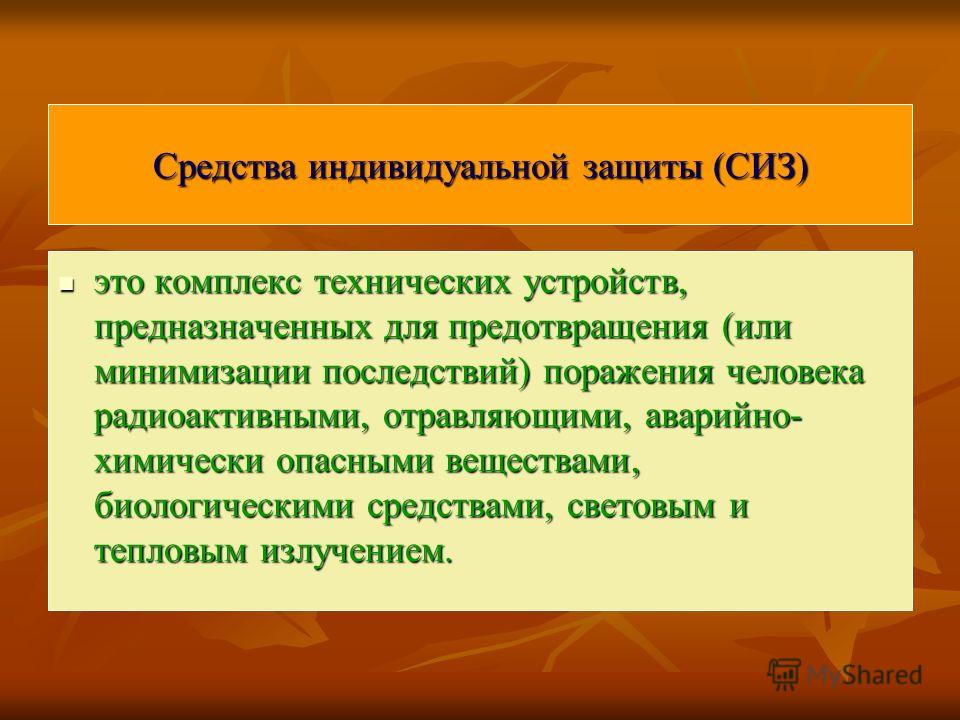
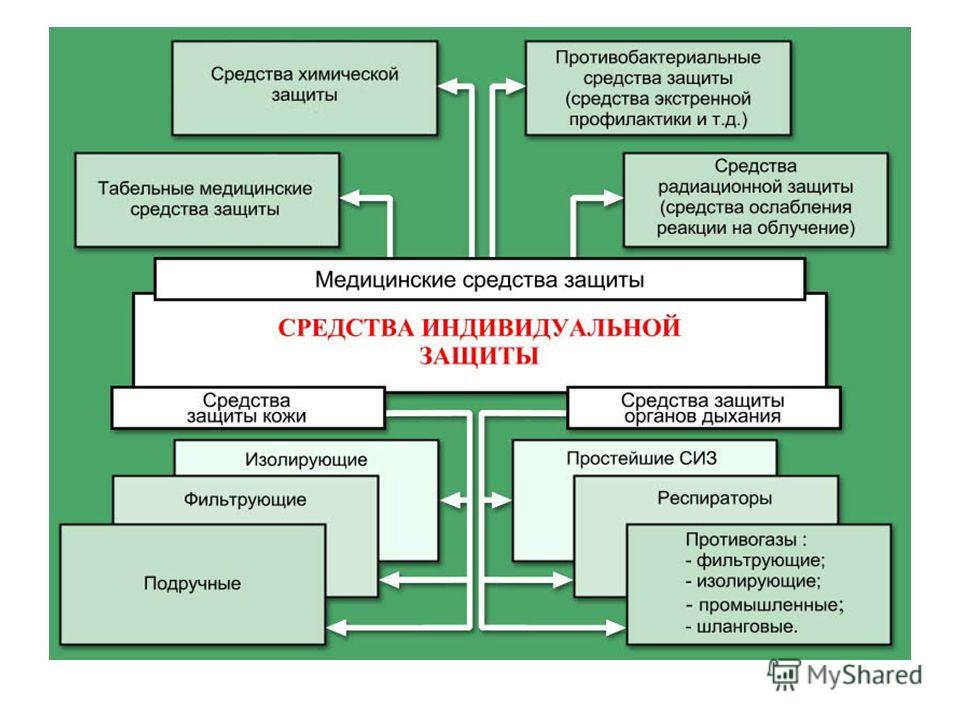
By functional purpose: Basic: - means of skin protection; - Respiratory protection equipment (RPE); - eye protection; - medical means of protection and prevention; - fire-fighting personal protective equipment (allocated in recent times, taking into account the special tendency against fire safety). by the method of protective action: - filtering type (civil and industrial); - insulating type. by design: Gas masks, breathing apparatus, hose gas masks, self-rescuers, respirators, the simplest PPE - cotton gauze bandages, dust-proof fabric masks. Overalls, raincoats, stockings, gloves, creams, pastes. Glasses. First-aid kits, chemical and dressing bags, chemical radioprotectors .. The simplest fire extinguishing means, internal fire hydrants, fire extinguishers. Personal protective equipment classification:
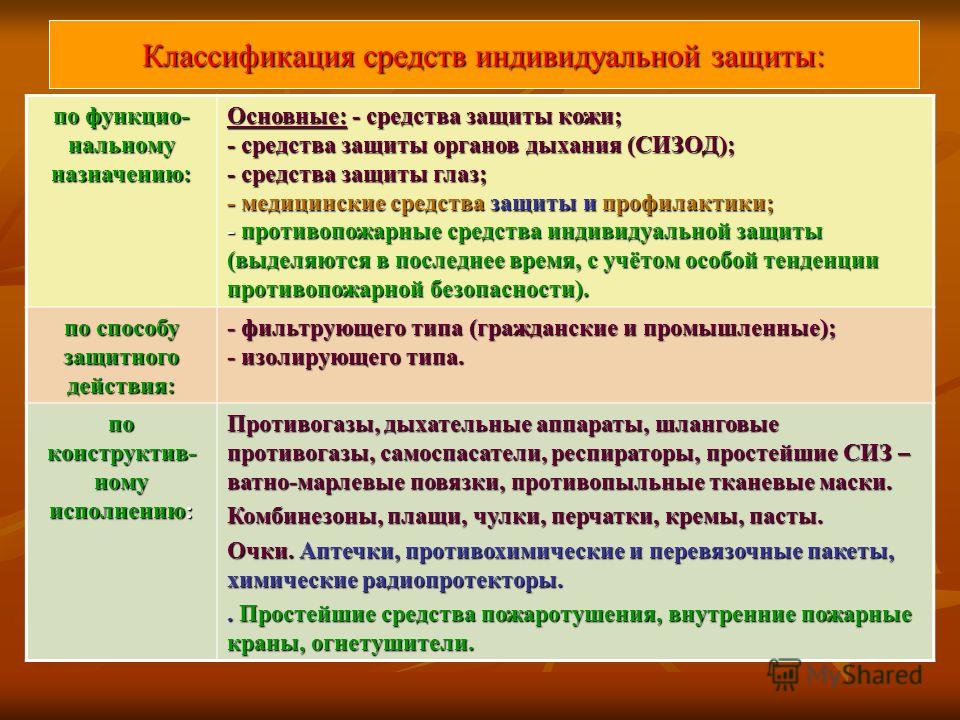
Provide protection in conditions of free oxygen content in the air (not less than 16%) and limited content of harmful substances - not more than 0.5% (phosphorous hydrogen - not more than 0.2%; arsenous hydrogen - not more than 0.3%). protect from radioactive (RS), toxic substances (OM), bacterial agents (BS), from a number of hazardous chemicals. For adults: - GP-7, GP-7VM, - (GP-5) - "UZS VK" - GP - 7BV (GP-7B), GP-10. For children: -PDF-2D (for preschoolers); -PDF-2SH (for schoolchildren); - protective cameras for children KZD-4, KZD-6 (up to 1.5 years). - Protective kit for children preschool age with forced air supply ZKD - GZ Filtering RPE
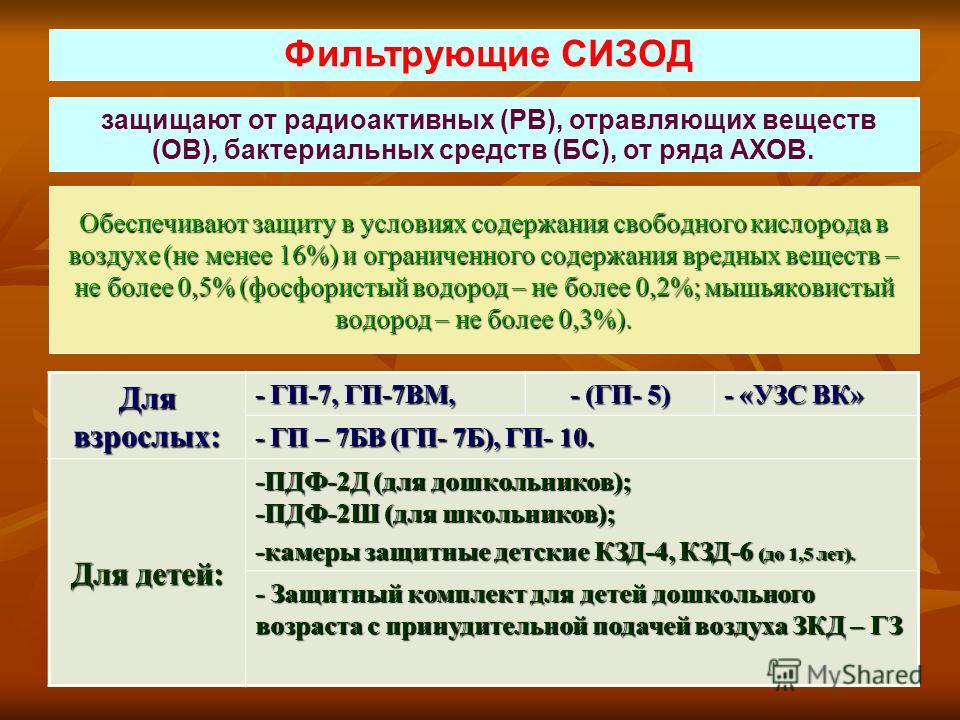
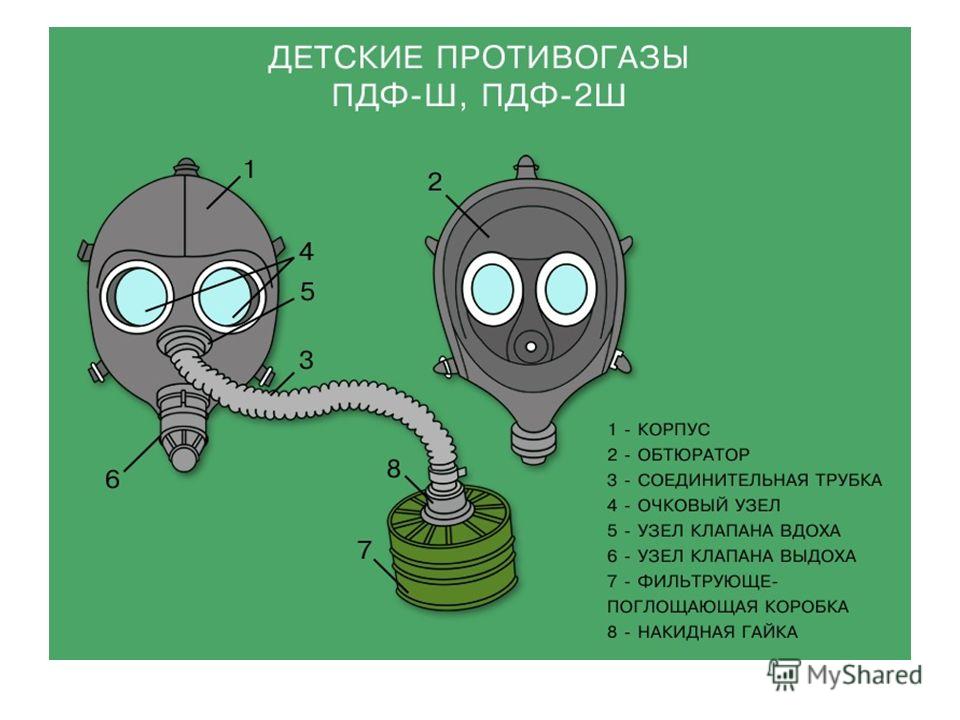
Civilian gas mask GP - 7VM (beginning): GP-7VM - gas mask of the 90s. GP-7VM - gas mask of the 90s. FPK GP-7x is used; FPK GP-7x is used; the front part of MB-1-80 allows attaching the FPK both on the left and on the right side; the front part of MB-1-80 allows attaching the FPK both on the left and on the right side; has an intercom and a device for receiving water; has an intercom and a device for receiving water; glasses of the spectacle assembly have a trapezoidal shape and bending radius, which improves the view and makes it possible to work with optical devices. the glasses of the spectacle assembly have a trapezoidal shape and a bending radius, which improves visibility and makes it possible to work with optical devices.
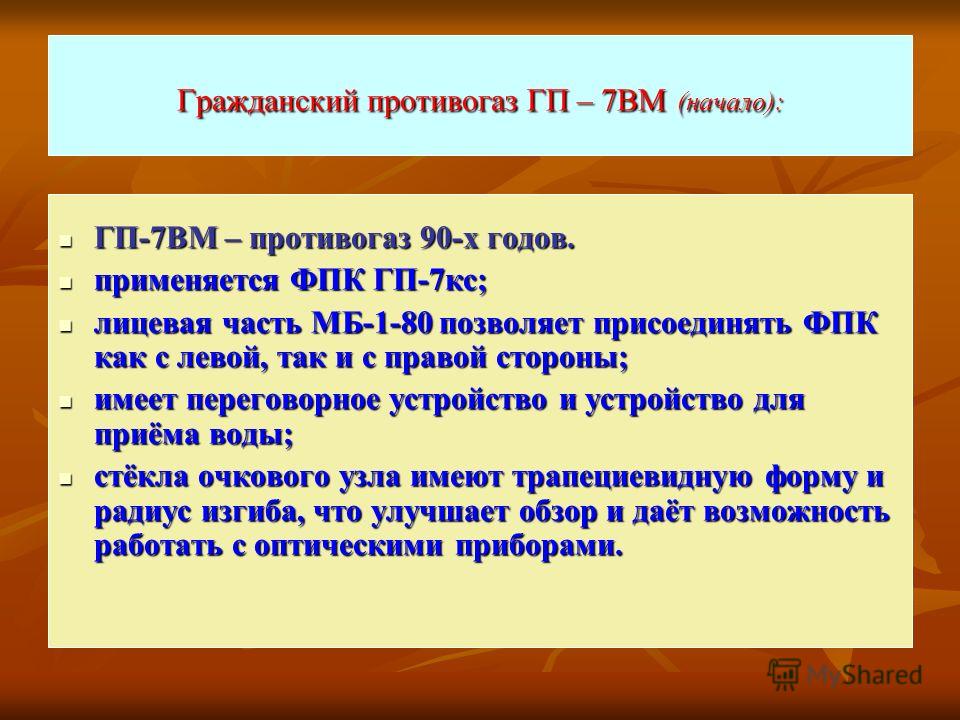
Protects: protects: from hazardous chemicals: chlorine, hydrogen sulfide, hydrocyanic acid, tetraethyl lead, methyl mercaptan, furfural, cyanogen chlorine; from AHOV: chlorine, hydrogen sulfide, hydrocyanic acid, tetraethyl lead, methyl mercaptan, furfural, chlorocyanogen; from vapors of organic substances: gasoline, kerosene, acetone, benzene, xylene, toluene, alcohols, ethers, benzene nitro compounds. from vapors of organic substances: gasoline, kerosene, acetone, benzene, xylene, toluene, alcohols, ethers, benzene nitro compounds. Time of protective action: Time of protective action: - from OM vapors - up to 6 hours; - from drops of mustard gas - up to 2 hours. does not protect: does not protect: from methane, ethane, butane, ethylene, ammonia. from methane, ethane, butane, ethylene, ammonia. Civilian gas mask GP - 7VM (continued):
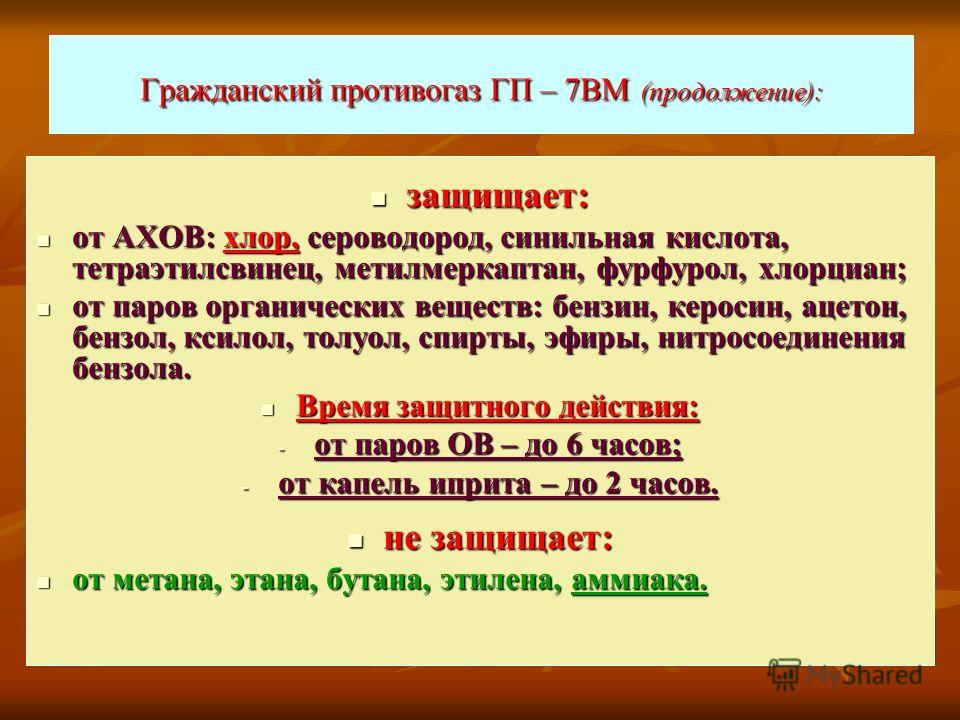
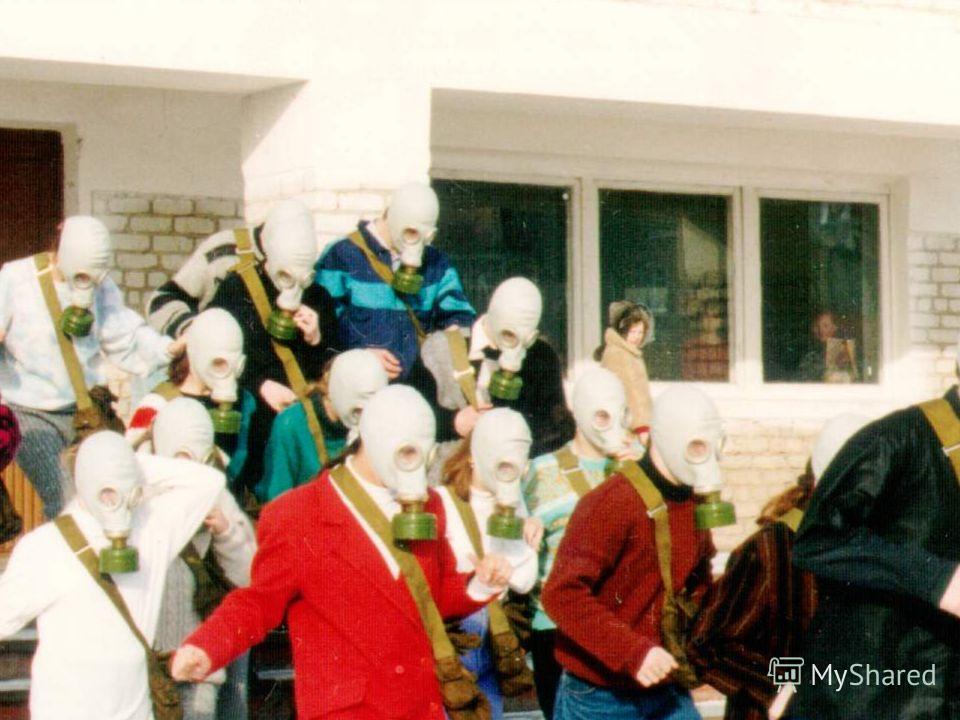
Civilian gas mask GP - 7VM (end): DP - 1 DPG - 3 To increase the protective effect of GP - 7VM, as well as to create protection against hazardous chemicals, additional cartridges are intended: DP - 1, DP - 2, DPG - 3. To increase the protective effect GP-7VM, as well as to create protection against hazardous chemicals, additional cartridges are intended: DP-1, DP-2, DPG-3. Protection against ammonia, chlorine, phenol, hydrocyanic acid, phosgene, carbon disulfide. hydrogen sulfide, nitrogen dioxide, carbon monoxide, ethylene oxide. Protection against ammonia, chlorine, phenol, hydrocyanic acid, phosgene, carbon disulfide. hydrogen sulfide. The time of the protective action (at a concentration of 5 mg / l) for ammonia is 30 min. chlorine 40 min. ammonia 50 min. chlorine 40 min. The universal protective system "VK" "UZS VK") is designed to protect the respiratory system and eyes from RV, BS, OM and AHOV (including ammonia, chlorine, dimethylamine, nitrobenzene, hydrogen sulfide, carbon disulfide and others). designed to protect the respiratory system and eyes from RV, BS, OM and AHOV (including ammonia, chlorine, dimethylamine, nitrobenzene, hydrogen sulfide, carbon disulfide and others). This is a commercial development, as an alternative to gas masks GP-7, GP-V, GP-7VM with an additional cartridge DPG-3. This is a commercial development, as an alternative to gas masks GP-7, GP-V, GP-7VM with an additional cartridge DPG-3.
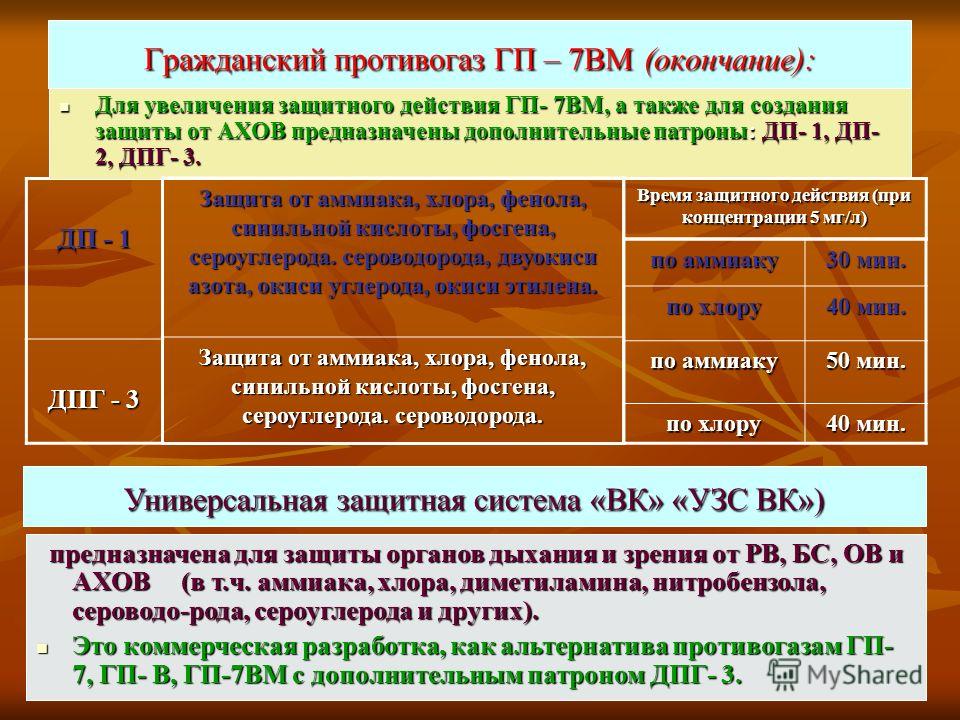
Civilian gas masks GP-7BV (GP-7B) Developed within the framework of the State Defense Order under the leadership of the Ministry of Emergencies of the Russian Federation in 2008. Developed within the framework of the State Defense Order under the leadership of the Ministry of Emergency Situations of the Russian Federation in 2008. Designed to protect against chemicals, a wide range of hazardous chemicals (including ammonia and chlorine), radioactive substances (including radioisotopes of iodine and its organic compounds), biological aerosols. Designed to protect against chemicals, a wide range of hazardous chemicals (including ammonia and chlorine), radioactive substances (including radioisotopes of iodine and its organic compounds), biological aerosols. Kit weight (without bag) - 950 grams. Kit weight (without bag) - 950 grams. The shelf life is 25 years. The shelf life is 25 years. Time of protective action (in minutes) with FPK GP-7kB with FPK GP-7kB- "Optim" - for ammonia (at a concentration of 0.7 mg / cubic dm) - not less than 50 - for chlorine (at a concentration of 3 g / m3 dm) not less than 20 Consists of: - front part of MP-07V with a device for receiving water; - FPK GP-7kB or GP-7kb- "Optim". Consists of: - the front part of the MP-07V with a device for receiving water; - FPK GP-7kB or GP-7kb- "Optim".
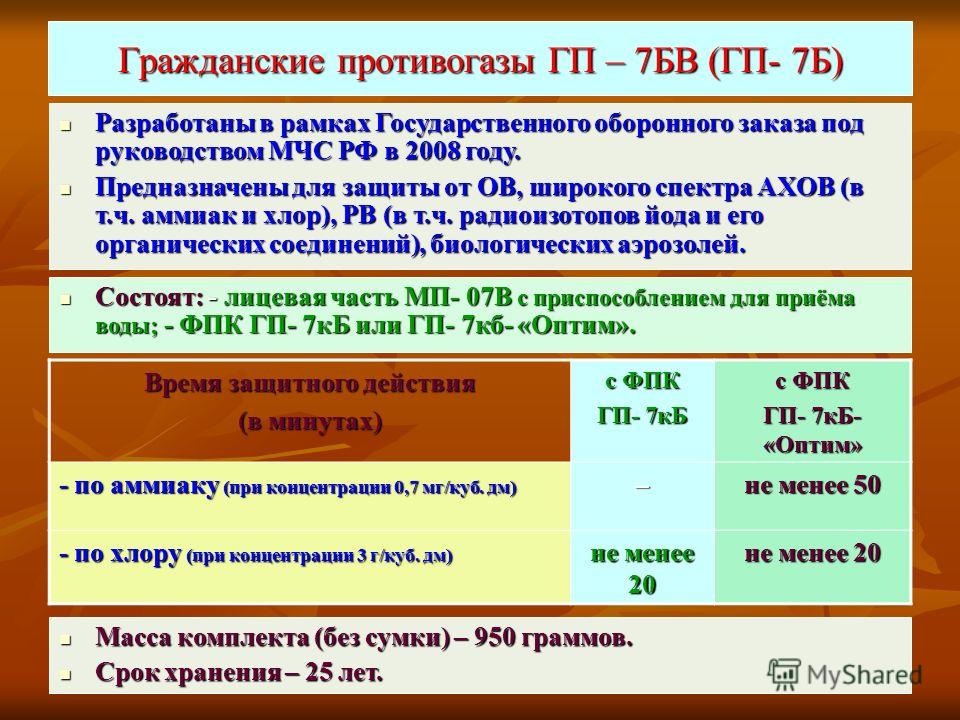
Civilian gas mask GP - 10 Developed within the framework of the State Defense Order under the leadership of the Ministry of Emergency Situations of the Russian Federation in 2008. Developed as part of the State Defense Order under the leadership of the Ministry of Emergency Situations of the Russian Federation in 2008. Designed to protect against chemicals, a wide range of hazardous chemicals (including ammonia and chlorine), radioactive substances (including radioisotopes of iodine and its organic compounds), biological aerosols. Designed to protect against chemicals, a wide range of hazardous chemicals (including ammonia and chlorine), radioactive substances (including radioisotopes of iodine and its organic compounds), biological aerosols. Kit weight (without bag) - 900 grams. Kit weight (without bag) - 900 grams. The shelf life is 25 years. The shelf life is 25 years. Time of protective action against vapors of hazardous chemicals at concentrations up to 100 MPC (in minutes) - for ammonia not less than 60 - for chlorine not less than 60 Consists of: - front part - panoramic mask MPF-2; - two FPK: GP-10K; Consists of: - front part - panoramic mask MPF-2; - two FPK: GP-10K;

Protective kit for preschool children with forced air supply "ZKD - GZ" Developed within the framework of the State Defense Order under the leadership of the Ministry of Emergency Situations of the Russian Federation in 2008. Developed within the framework of the State Defense Order under the leadership of the Ministry of Emergency Situations of the Russian Federation in 2008. Designed to protect against chemicals, a wide range of hazardous chemicals (including ammonia and chlorine), radioactive substances (including radioisotopes of iodine and its organic compounds), biological aerosols. Designed to protect against chemicals, a wide range of hazardous chemicals (including ammonia and chlorine), radioactive substances (including radioisotopes of iodine and its organic compounds), biological aerosols. Putting on and sealing time - 5 minutes. Kit weight (without bag) - 3 kg. Dimensions when placed in a bag (cm) - 40x15x27. Dimensions when placed in a bag (cm) - 40x15x27. The shelf life in the manufacturer's packaging is 10 years. The shelf life in the manufacturer's packaging is 10 years. Time of protective action (in hours) - from OM VX, mustard gas (when exposed to 3 mg min / dm3) 6 - from AHOV (chlorine, ammonia - at a concentration of 1.5 mg / dm3) 1.5 Consists of: - FPK "FPK A282E2K2NOP3"; - protective jacket - hood; - connecting tube with air supply indicator; - microelectric fan with power supply unit (for 10 hours); - helmet - comforter. Consists of: - FPK "FPK A282E2K2NOP3"; - protective jacket - hood; - connecting tube with air supply indicator; - microelectric fan with power supply unit (for 10 hours); - helmet - comforter. Microclimate parameters inside the protective kit Volume concentration of carbon dioxide in the breathing zone (in%) 1.2 Volume concentration of oxygen in the breathing zone (in%) 18
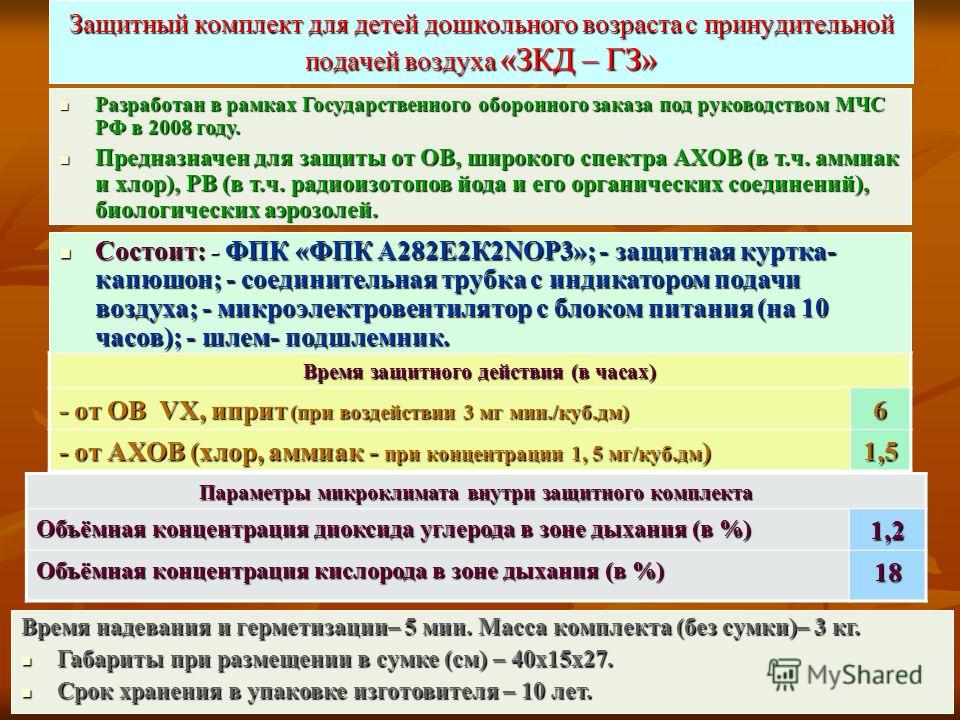

Industrial gas masks Gas masks PPFM-92 (95), PFMG-96, PFSG-98, (modular type) made it possible to significantly expand the range of their use by providing simultaneous protection from various harmful impurities. Gas masks PPFM-92 (95), PFMG-96, PFSG-98, (modular type) made it possible to significantly expand the range of their use by providing simultaneous protection against various harmful impurities. Filtering and absorbing boxes KPF-1, helmet-masks PPM-88, ShMP, MGP are used. Filtering and absorbing boxes KPF-1, helmet-masks PPM-88, ShMP, MGP are used. All brands differ in composition and volume of the absorber, color coloration and markings. All brands differ in composition and volume of the absorber, color coloration and markings. Designed to protect workers and employees associated with use in technological processes AHOV (gases, vapors, dust, smoke, fog) in an atmosphere containing at least 17% of free oxygen and no more than 0.5% of harmful impurities.

Characteristics of filtering and absorbing boxes of industrial gas masks FPK marking FPK painting color Scope of application Time of protection until 2005 from 2005 to 2005 from 2005 ААХ brown and brownOrganic vapors, chlorine. 50 minutes В В, Е yellow black-yellow Acid gases and vapors (chlorine), phosgene, organochlorine pesticides. 20 - 27 minutes Г HgP3 black with yellow red with white Mercury vapors, organic mercury toxic chemicals. 100 hours. KD No gray No No No No KG green green Ammonia COSX white violet Carbon monoxide MSX red violet Carbon monoxide, ammonia, organic vapors, acid gases and vapors, organochlorine compounds. BKSX yellow with green violet Acid gases and vapors, Organic gases and vapors, ammonia, ethylene oxide, phosphorus and organochlorine compounds.

Insulating RPE - personal protective equipment for the respiratory system, face and eyes from any harmful impurities in the air, regardless of its concentration. Insulating RPE - personal protective equipment for the respiratory system, face and eyes from any harmful impurities in the air, regardless of its concentration. - when the composition and concentration of hazardous chemicals are unknown; - with a lack of oxygen in the air; - when the time of protective action of filtering gas masks is not enough to perform work in the emergency area. - when the composition and concentration of hazardous chemicals are unknown; - with a lack of oxygen in the air; - when the time of protective action of filtering gas masks is not enough to perform work in the emergency area. Isolating RPE provide protection in the following conditions: Isolating RPE provide protection in the following conditions:
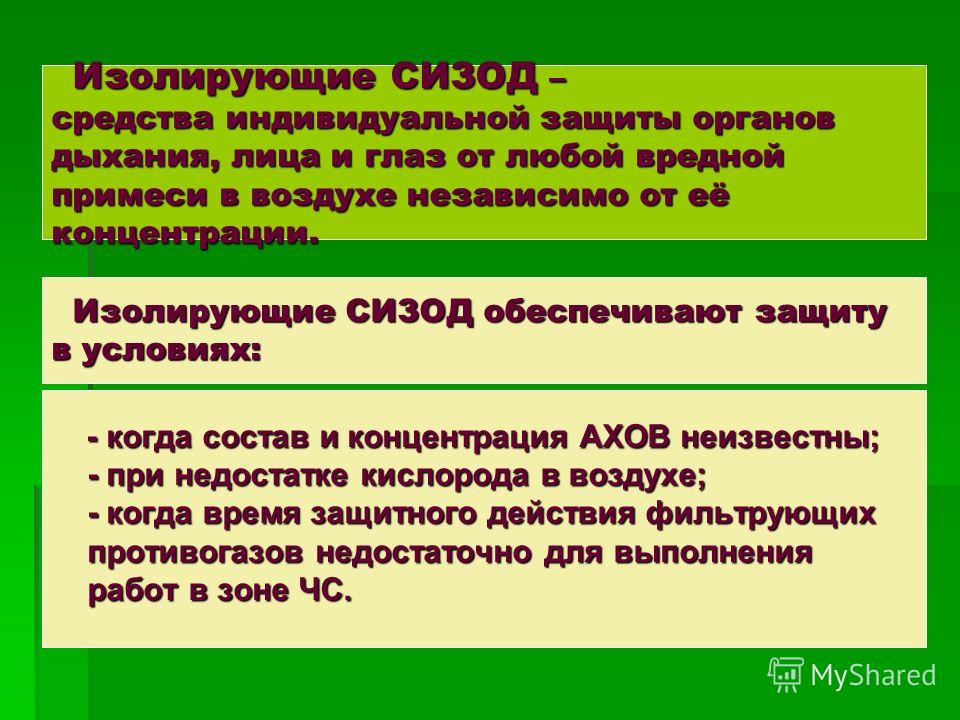
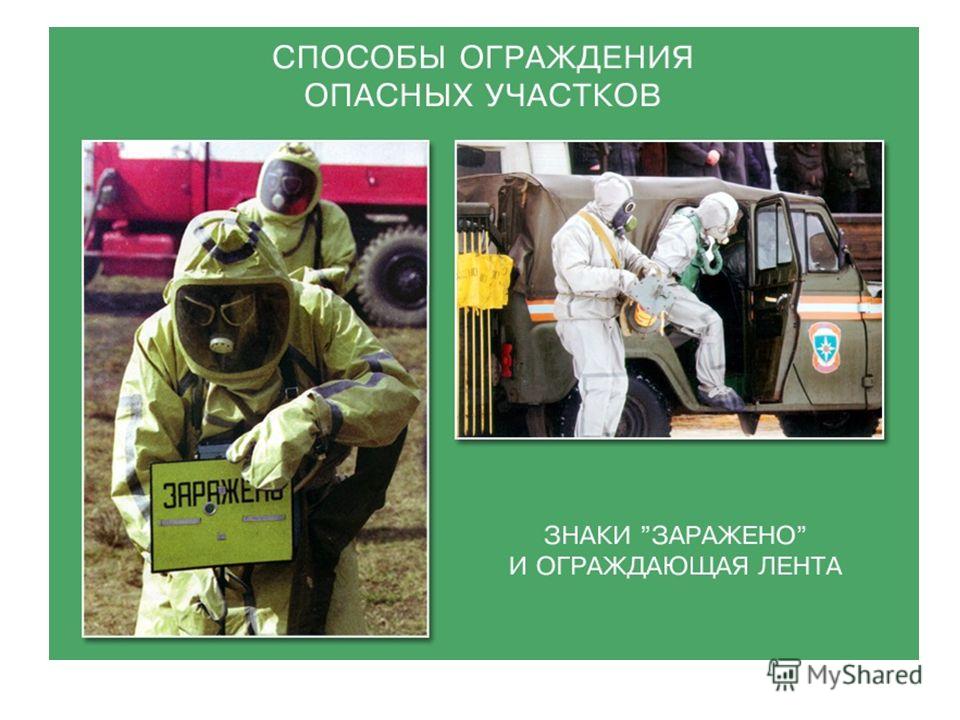
Isolating RPE Breathing apparatus Oxygen-isolating protivogas Oxygen respirators Self-rescuers ASV - 2 KIP - 8; Instrumentation - 9; IP - 4; IP - 5; IP - 6. R - 12m; P - 30; RVL - 1; "Ural - 7". SPI - 20; Remote control - 3; PDA; SHSS - T; PSh - 1B; PSh - 20 RV; PSh - 40 RV. Standalone Hose

Respirators (filtering) By design Respirators with a half mask (the inhaled air is cleaned in filter cartridges attached to the half mask). Respirators in the form of half masks (the half mask itself is a filtering element). By service life Disposable (ShB-1, U - 2K, "Petal", "Kama", "Alina - 200 AVK"). Reusable (it is possible to replace filters) - (RPG-67, RU-60m, RU-60 MU, RU-92 SN). Filter cartridges for respirators of grades A, B, KD, G are identical to industrial gas masks. In the absence of a gas mask and a respirator, dust-proof fabric masks PTM-1 and cotton-gauze bandages are used to protect the respiratory system.
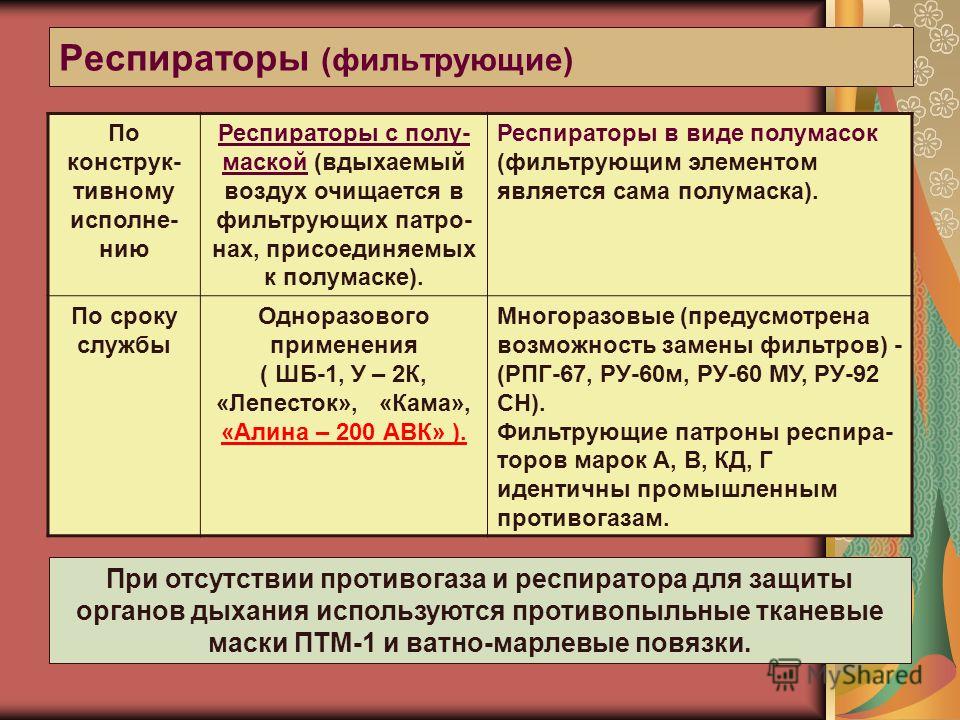
Personal protective equipment for skin PPE of skin of an insulating type PPE of a skin of a filtering type The material is covered with special films that do not allow liquid and gaseous hazardous chemicals to pass through. The material is impregnated with special compounds that neutralize or sorb AHOV vapors. Used with filtering gas masks.

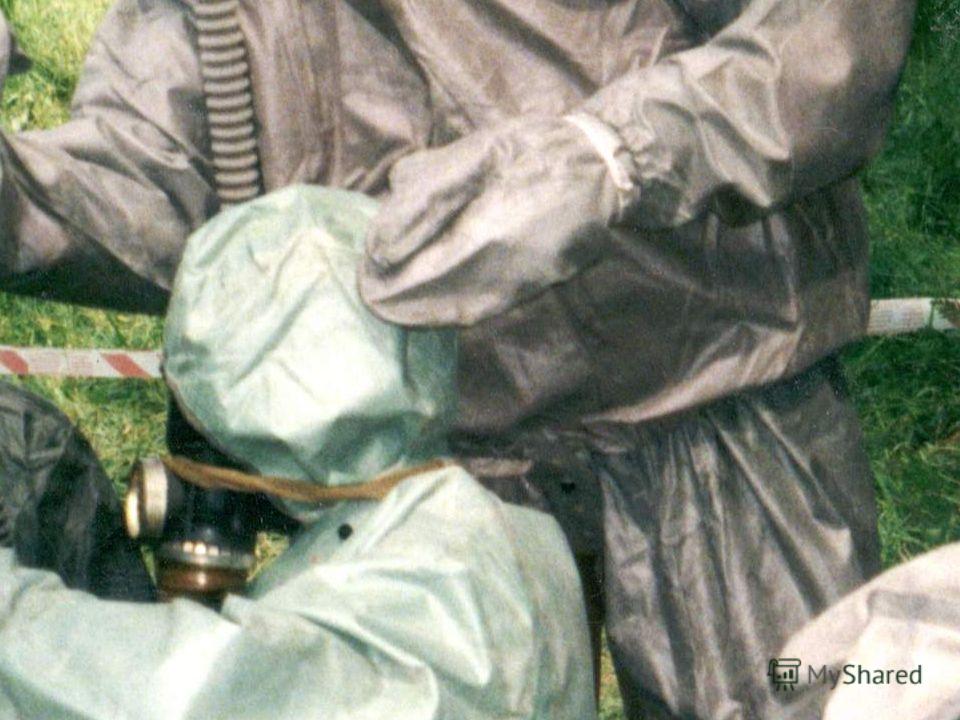
PPE insulating type of skin (beginning) - Insulating chemical kit FIR - 4 (FIR - 5); - Lightweight protective kit "L - 1"; - Protective insulating kit "Ch - 20"; - Isolating suits "IE - 1"; "Chromat"; - Insulating kit "Methanol"; - Emergency protective kit "KZA". - Protective insulating kit with ventilated undersuit space "I-20"; - Protective ointments, pastes, creams, cleaners.
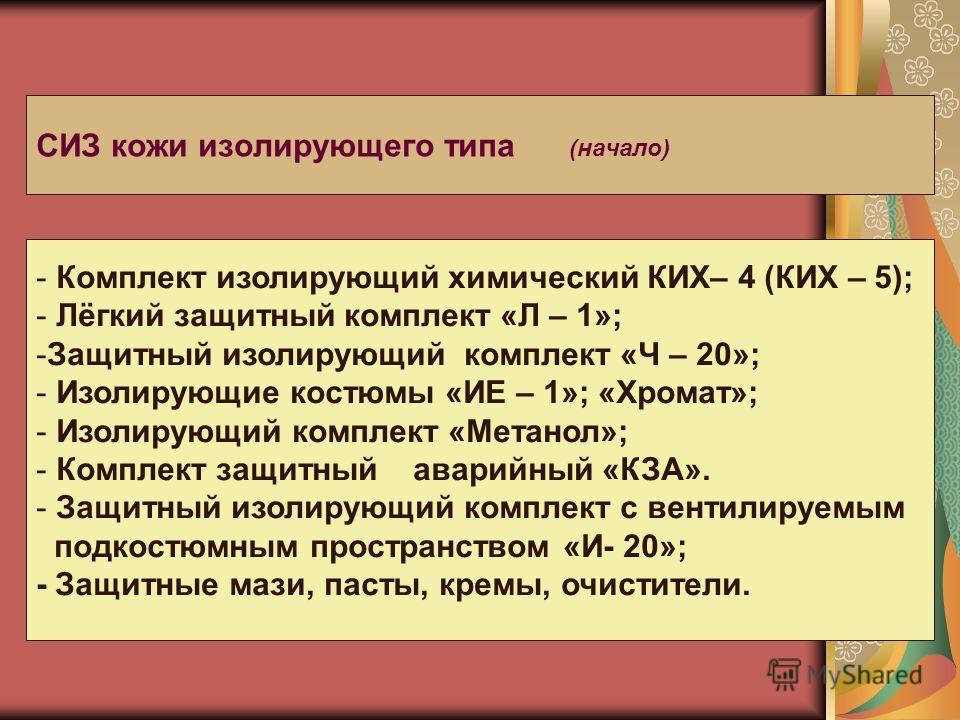
PPE of insulating type skin (end) According to purpose and physicochemical properties, they are divided into three groups: 1 - protect the skin of hands from water, solutions of acids, alkalis, salts, water and soda-oil products, etc. Preparations are not wetted with water and will not dissolve in her (hydrophobic drugs). Refers to: silicone hand cream (TU k / 73) IER-2 paste. 2 - protects the skin of the hands when working with anhydrous organic solvents, petroleum products, oils, fats, varnishes, resins; silicone cream PMS-30 (from fiberglass and chemical fibers); IER-1 paste; Hiot-6 paste; cream "Film-forming". VILPRAN + liquid gloves. 3 - cleaners: soap, alkalis, salts, surfactants: Rally paste; autologous ointment. Protective ointments, pastes, creams, cleaners. The main purpose of their use is to create a reliable barrier between the skin and irritants acting on it (AHOV).
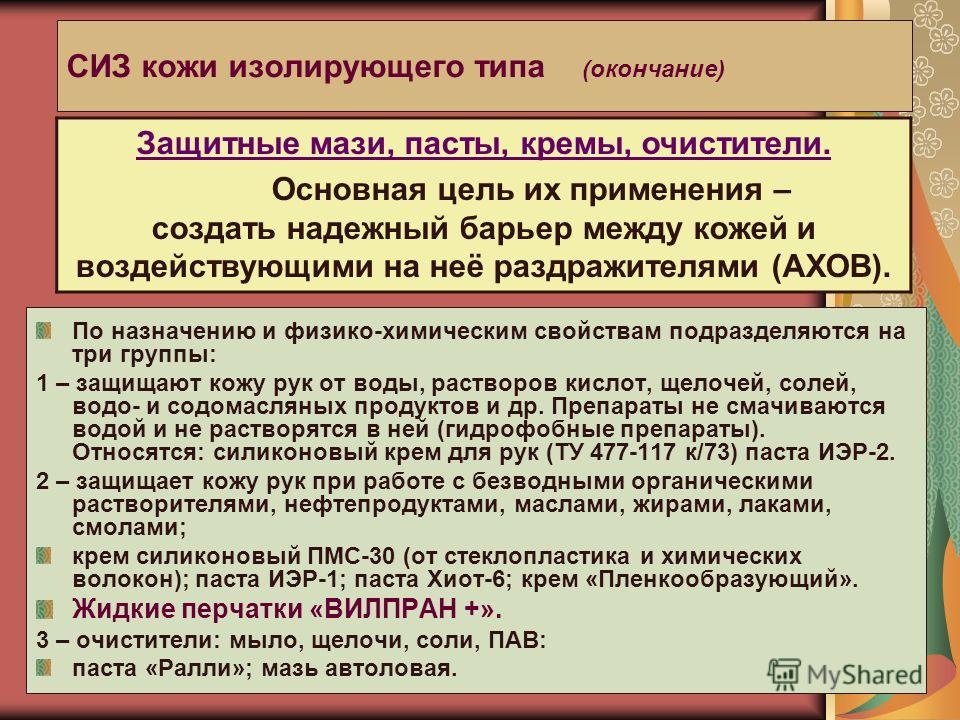
PPE of the skin of the filtering type - Protective and filtering clothing "ZFO"; - Protective kit "FL - F"; - Protective kit "FL - N"; - Protective clothing "ARK - 1"; - Protective kit "PZO - 2"; - Protective kit "KZKHI". - Filtering protection clothing FZO-MP; - Suit anti-alkaline acid PDA; - Combined-arms protective kit OZK. The simplest means of skin protection are handy, retrofitted household and industrial clothing and footwear.
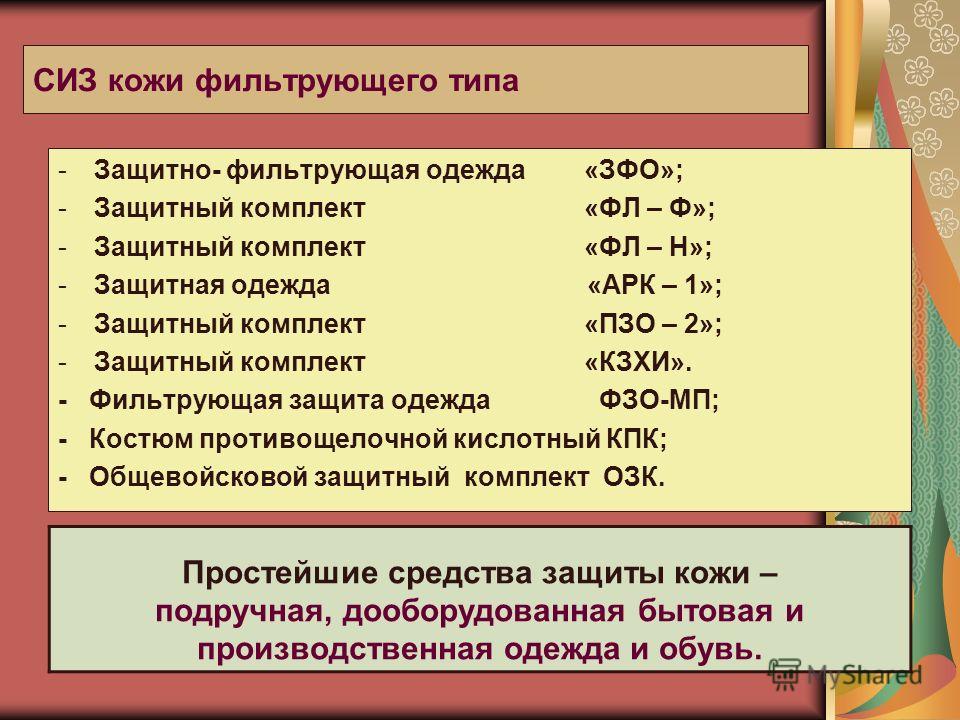
The simplest means of respiratory and skin protection Industrial clothing (overalls, jackets, trousers, overalls), robes with hoods, made of tarpaulin, fire-retardant or rubberized fabric, rough cloth. Tarpaulin protects - 1 hour. Rubberized fabric - min. Winter things: coats made of coarse cloth, drape, quilted jacket, which protect from 20 to 60 minutes. Boots, rubber boots and galoshes are used to protect the feet. Various dust goggles can be used to protect the eyes.

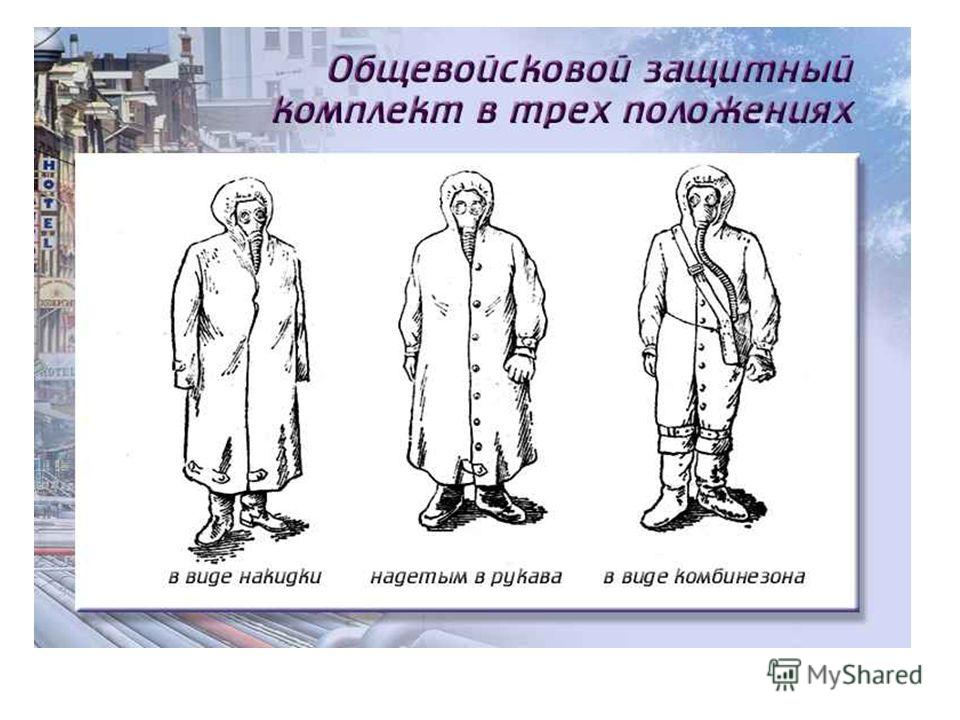
When using clothing as a means of protecting the skin, it is necessary to carefully seal it, it must be buttoned, tucked in, and some parts must be tightened with a belt. The simplest means allow you to go beyond the foci of infection and protect a person from direct contact with hazardous chemicals. Anti-dust fabric mask PTM-1 protects against radioactive dust and bacterial aerosols. A cotton-gauze bandage (VMP) is made from a piece of gauze 100 cm long and 50 cm wide, in the middle part of the bandage an even layer of cotton wool 30x20 cm in size and 20 cm thick is placed.For children: 80x40 cm, a layer of cotton wool 20x15 cm.
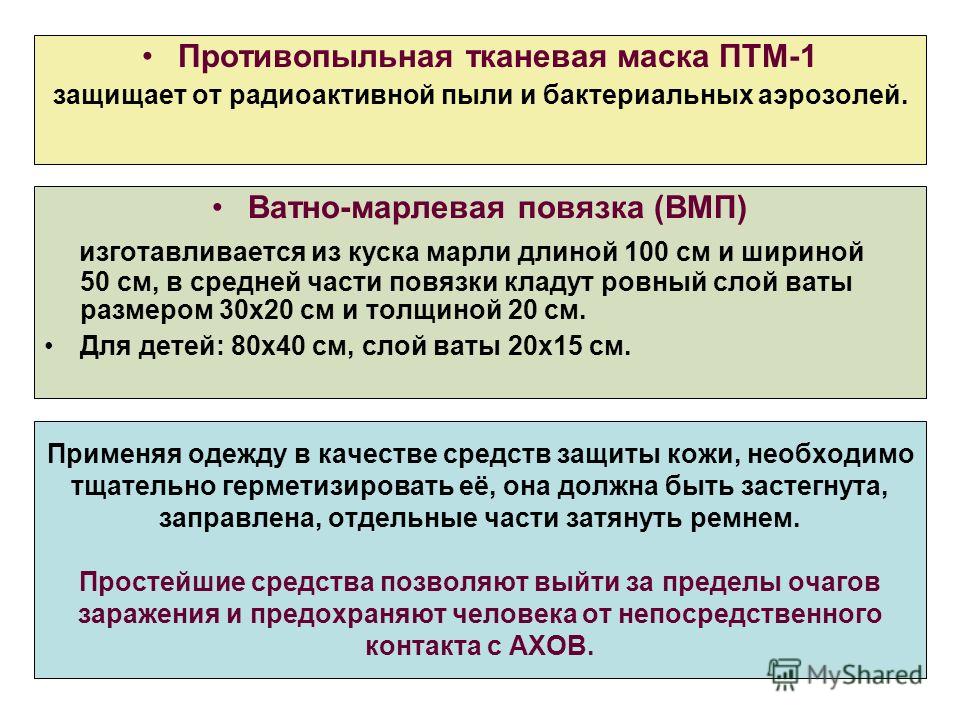

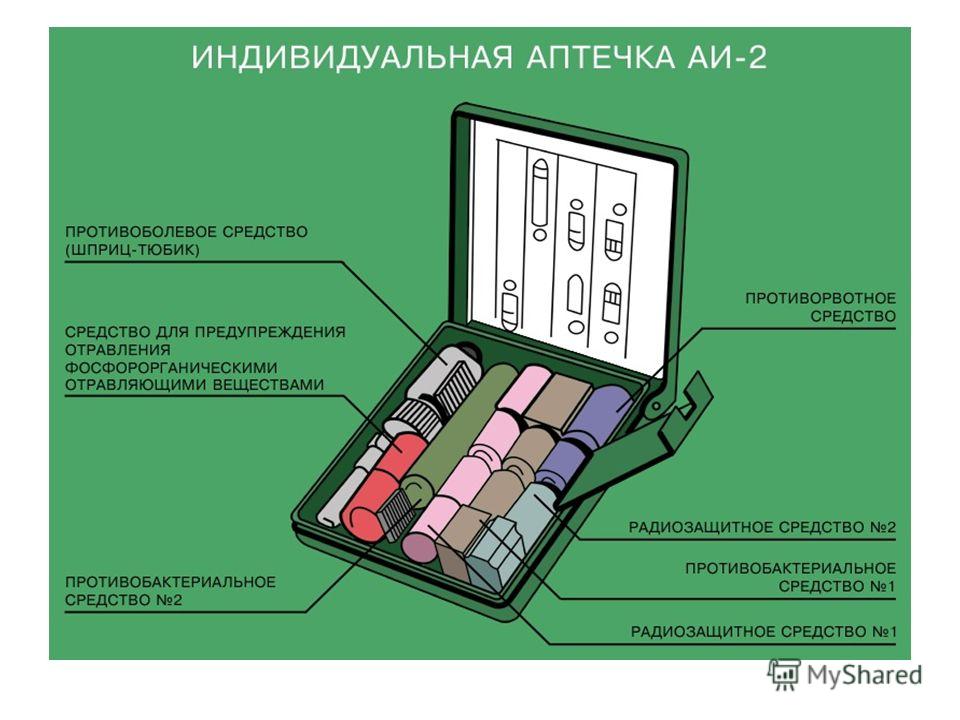
Standard medical protective equipment Personal first-aid kits (AI-2, AI-modified) (pain relievers - analgesics, antidotes, anti-inflammatory, antibacterial, radioprotective agents). Antidotes (Athens, the drug "P - 100", Budaxin, Taren,). Anti-chemical packages (IPP - 8, IPP - 9, IPP - 10, IPP - 11). Individual dressing packages (PPI, PPI AV-3). Stable iodine preparations.
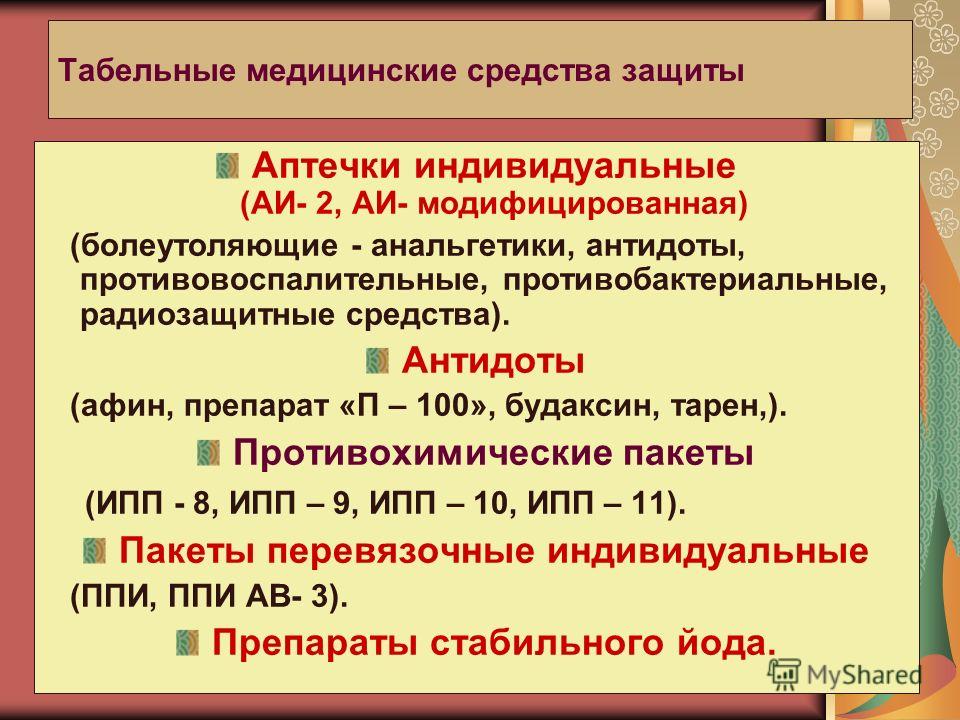
AI-1M - 2% Promedol solution, 1.0 in a syringe tube. - Budaksin, 1.0 in a syringe tube. For pain relief: injected subcutaneously or intramuscularly. Antidote to organophosphorus toxic substances. It is injected subcutaneously when the first signs of OPF appear. AI-2 Reserve socket for a syringe-tube with an analgesic agent (narcotic analgesic - 2% solution of promedol). Completed by separate order. Antidote from FOV - Taren, 6 tab. in a red pencil case. Take: 1 tab. - with the threat of destruction of the FOV. 2 tab. - upon detection of the first signs of FOV lesion (difficulty breathing, drooling, visual impairment). Antibacterial agent 2 - Sulfademitoxin, 15 tab. Take: 7 tab. on the first day when symptoms of gastrointestinal upset appear. In the next 2 days - 4 tab. Radioprotective agent 1 - Cystamine, 12 tab. in 2 pink pencil cases. Take: - 6 tablets when alerting the population about the radiation hazard or minutes before entering the RA contamination zone. If the duration of stay in the RA contamination zone is more than 5 hours, take the contents of the second case. Antibacterial agent 1 - Chlortetracycline, 10 tab. in 2 cases with square cases. Take: 5 tab. as a means of emergency non-specific prophylaxis upon receipt of an order from the medical staff; when the enemy uses bacteriological weapons; when the surrounding infectious diseases appear; when receiving extensive wounds (burns). After 6 hours, take another 5 tab. Radioprotective agent 2 - Potassium iodide, 10 tab. in a white pencil case. Take: 1 tab. every day for 10 days after the precipitation of RA, but not more than 10 days - for adults, 2 days - for children. Antiemetic - Eperazin, 5 tab. in a blue pencil case. 1 tab. 2 times a day if you feel nauseous, after staying in the area of RA infection, or if you have a head injury. Individual first aid kits
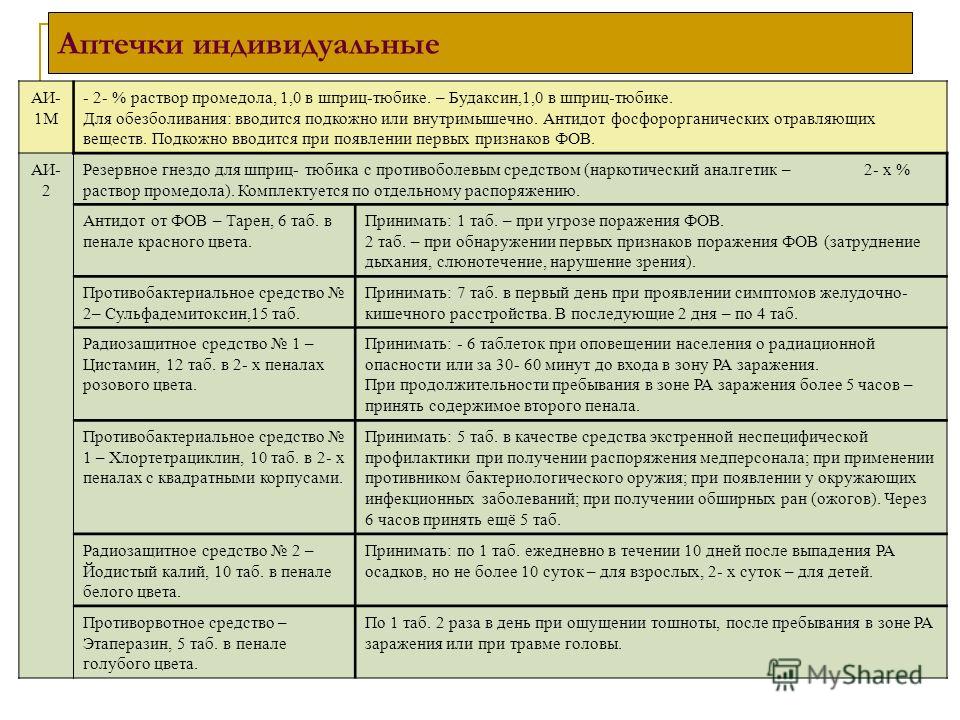
Reserve socket for a syringe-tube with an analgesic agent (narcotic analgesic - 2% solution of promedol). Completed by separate order. Antidote from FOV - Athens in a 1 ml syringe tube with a red cap. It is introduced at the first signs of FOV lesion (difficulty breathing, drooling, visual impairment). Radioprotective agent - Cystamine, 12 tab. 0, 2 in 2 cases of crimson color. Take: - 6 tablets when alerting the population about the radiation hazard or minutes before entering the RA contamination zone. If the duration of stay in the RA contamination zone is more than 5 hours, take the contents of the second case. Antibacterial agent - Doxycycline, 4 tab. 0.1 each. With the threat of damage by biological (bacterial) agents, with injuries (burns) - for the prevention of wound infection. Take 2 tab. every 12 hours. Means for the prevention of FOV poisoning - "Drug P-10M". 2 tab. In a pencil case yellow color... 1 tab. - with the threat of poisoning with OP. 2 tab. - in an hour., Upon detection of the first signs of damage. It is also accepted when the type of OV used by the enemy is unknown. Antiemetic - Eperazine, in a pencil case of blue color... 1 tab. 2 times a day if you feel nauseous, after staying in the area of RA infection, or if you have a head injury. Antiseptic agent - Iodine, 2 ampoules of 1 ml. It is used to treat the circumference of the wound. Means for water disinfection - Pantocid ", 20 tab. 1 tab. provides disinfection of 0.75 l of water (1 flask) after 15 minutes. after dissolving the tab. Individual first aid kit AI-2 (modified)
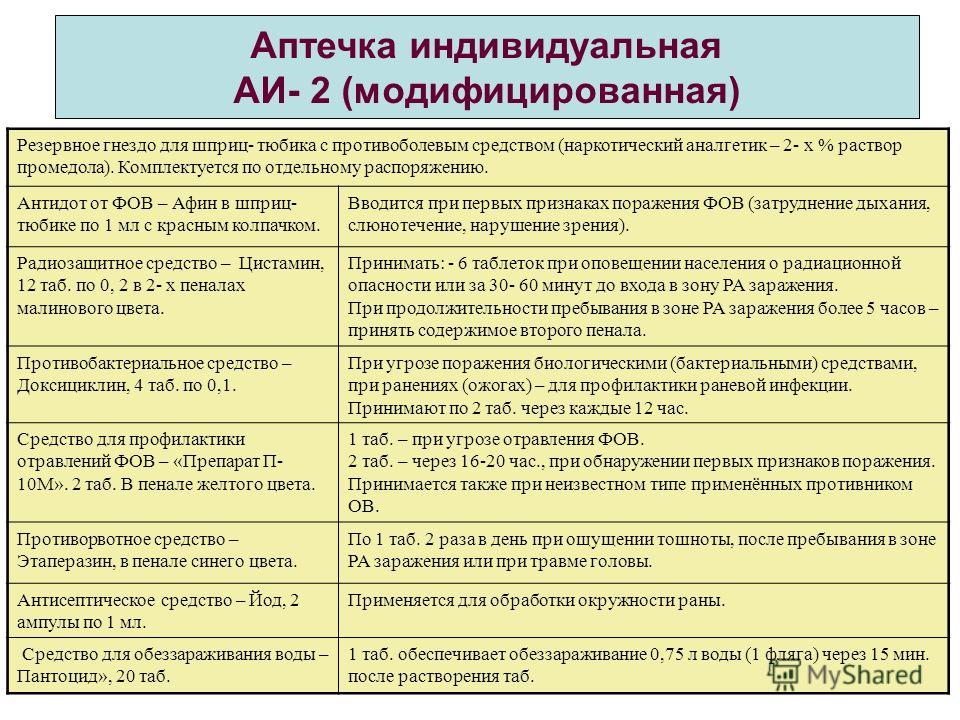
Individual medical kit civil protection"Yunita" (KIMGZ "Yunita") Developed within the framework of the State Defense Order under the leadership of the Ministry of Emergency Situations of the Russian Federation in 2008. Designed to provide first medical care(in the order of self- and mutual assistance in the event of emergencies in the foci of damage in order to prevent or minimize the effects of the impact of damaging factors of chemical, radiation and biological nature. The product can be used to provide first aid users who do not have special medical knowledge, in the absence of qualified medical care, to provide self- and mutual assistance in emergencies of a natural and man-made nature. Composition For storing attachments, a bag is used, which is a valve, a main cover into which a lining pocket with four compartments for special packing is inserted (hemostatic, disinfecting napkins, an individual dressing bag, a hemostatic tourniquet, an oral air duct) and an additional detachable patch pocket insert with horizontal compartments for inserting antidotes. The bag has a rectangular shape, the waist belt is a fixer made of a polyethylene strap and main fabric with plastic carabiners that can be adjusted to fit the waist. The flap of the bag completely closes and protects the pocket-insert from damage and mechanical impact; equipped with a fastener on the contact tape.
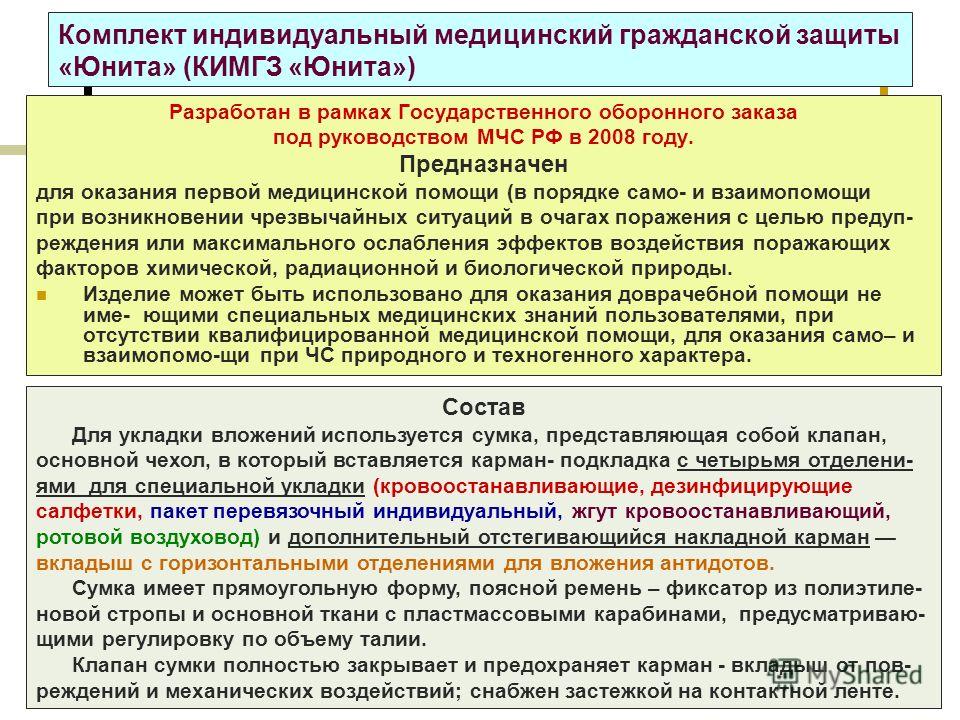
Acquisition of KIMGZ "Unit" medicines and products medical purpose(beginning) p / p Attachments Purpose Type of packaging Qty. 1Anticyanum 20% solution 1 ml. (in a syringe-tube) Antidote for cyanide poisoning Syringe-tube 1 2 Acyzol 6% solution 1 ml. (in a syringe-tube) Antidote for poisoning with carbon monoxide Blister pack 1 3 Beforal 0.2% solution 1 ml. (in a syringe-tube) Analgesic agent Syringe-tube 1 4 Pelixim - 1 ml. (in a syringe-tube) Antidote for OP poisoning Syringe-tube 1 5 Fitsilin - 2.0 (in an ampoule (aerosol)) Antidote for irritating substances Plastic ampoule 1 6 Doxycycline Antibacterial agent Penal 2
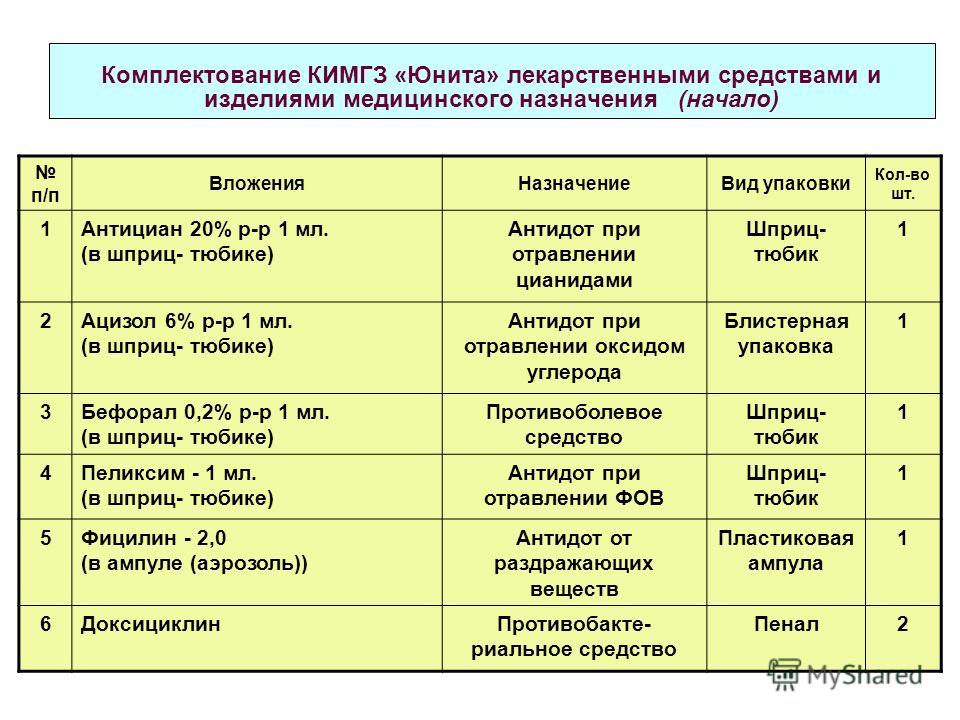
Completion of KIMGZ "Unita" with medicines and medical products (end) p / p Attachments Purpose Type of packaging Qty. 7 Potassium iodide Radioprotective agent Pencil case1 8 Hemostatic tourniquet Hemostatic products Packets 1 9 Hemostatic napkin1 10 Individual dressing package Dressing agent Package1 11 Disinfectant napkin Means for disinfecting hands Package1 12 Oral air duct For injections Packing 1 12 Oral air duct For injections 14 ml 1

IPP-8 Glass bottle with polydegassing liquid, four cotton-gauze swabs; instructions for use. For neutralization of hazardous substances in open areas of the skin and adjacent areas of clothing. IPP-10 Metal bottle with degassing liquid, four cotton-gauze swabs; instructions for use. It is used in accordance with the instructions. IPP-11 Hermetically welded casing made of polymeric material with inserted tampons made of non-woven material (according to the Langlik recipe). For protection and degassing of open areas of human skin from organophosphorus toxic substances (OPO). It is used once at a temperature from -20 ° С to + 40 ° С. It is used in accordance with the instructions. Anti-chemical packages
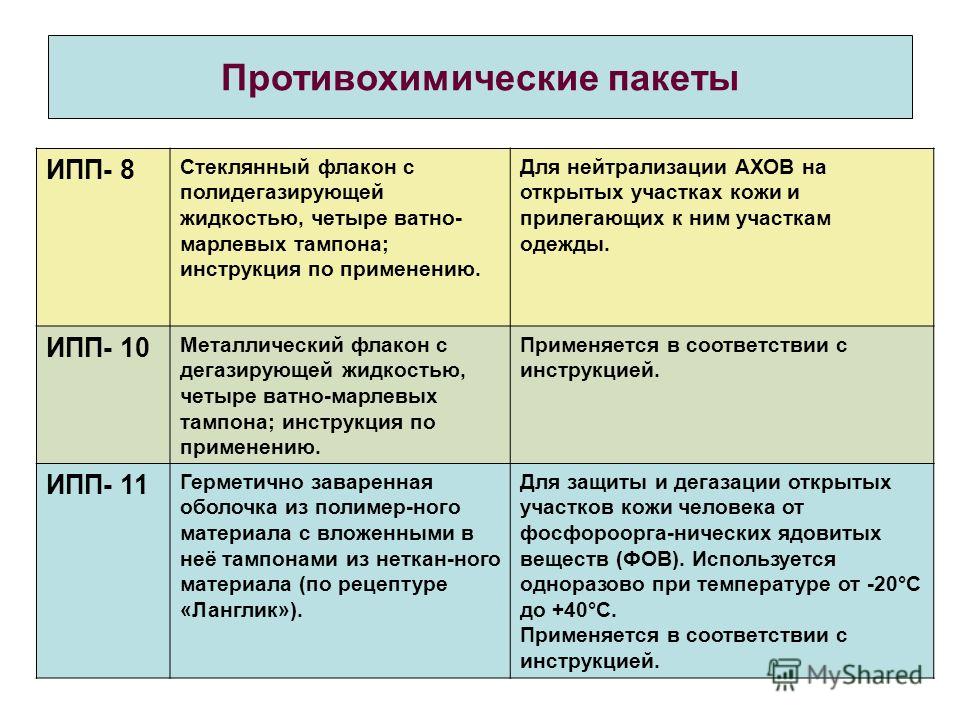
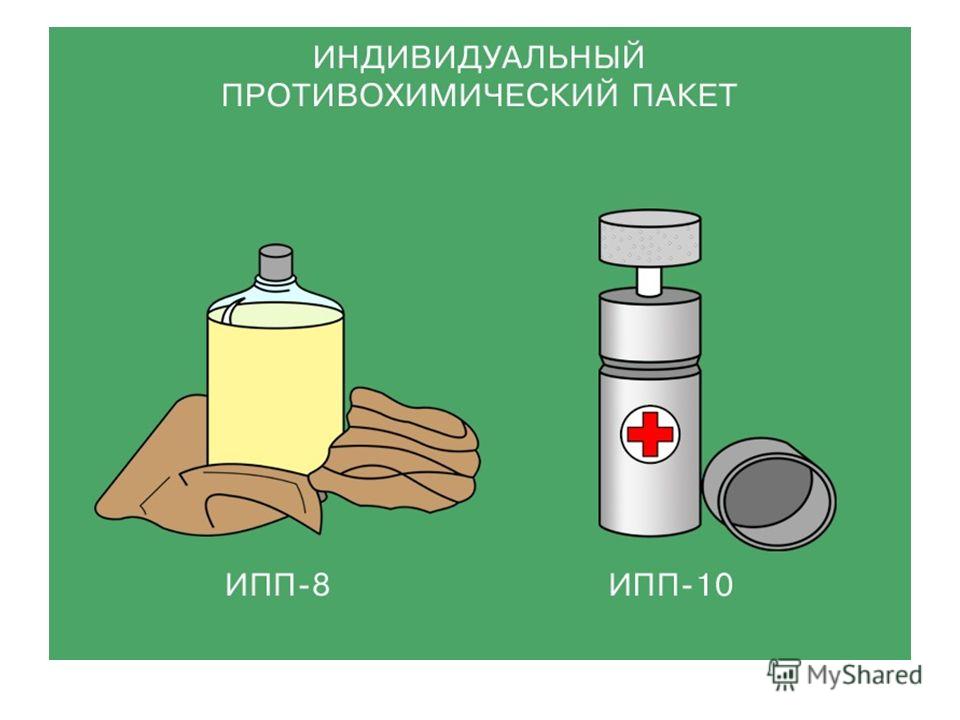
PPID, two sterile cotton and gauze pads, bandage, safety pin, rubberized sheath. For application: a primary dressing on a wound in order to prevent secondary microbial contamination; occlusive dressing for pneumothorax. PPI-AV-3 Two pads (movable and fixed), elastic fixing bandage. The pads have three layers: atraumatic - knitted mesh, sorption - from cotton-viscose fibers, protective - from non-woven polypropylene fabric. For emergency medical self- and mutual assistance. Sorption capacity and non-traumatic (does not stick to the wound surface, painlessly removed during dressings), moisture and microbial impermeability. It is used in accordance with the instructions. Individual dressing packages


Means of biological protection Means of emergency non-specific prophylaxis - (with an unknown pathogen): broad-spectrum antibiotics, sulfonamides, interferons). Means of specific prophylaxis - (when the pathogen is identified): antibiotics of a narrow spectrum of action, serums, toxoids, bacteriophages.
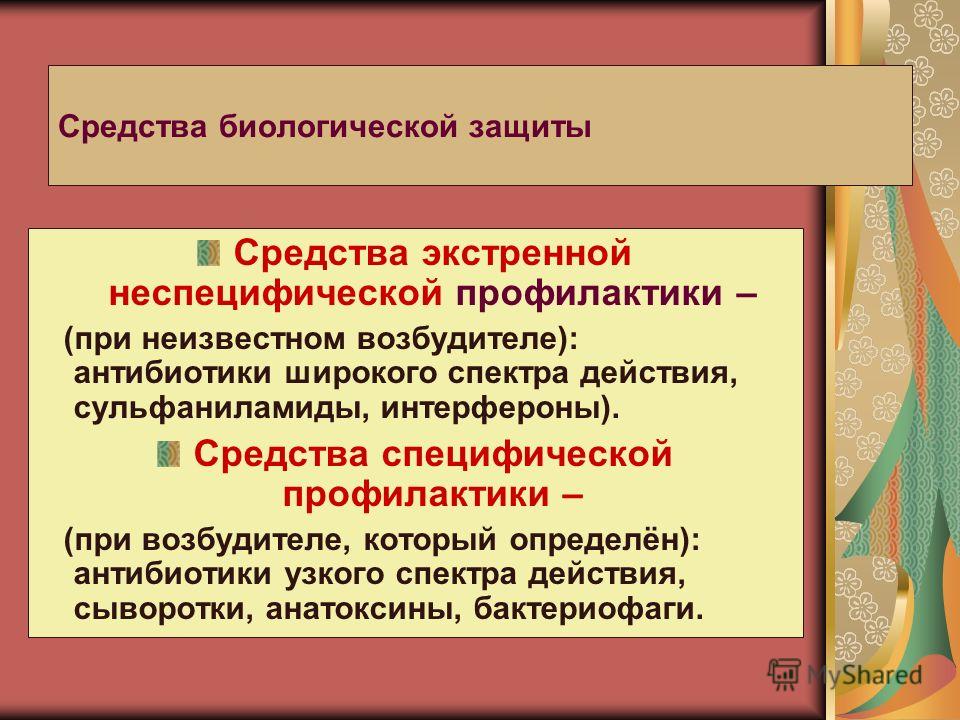
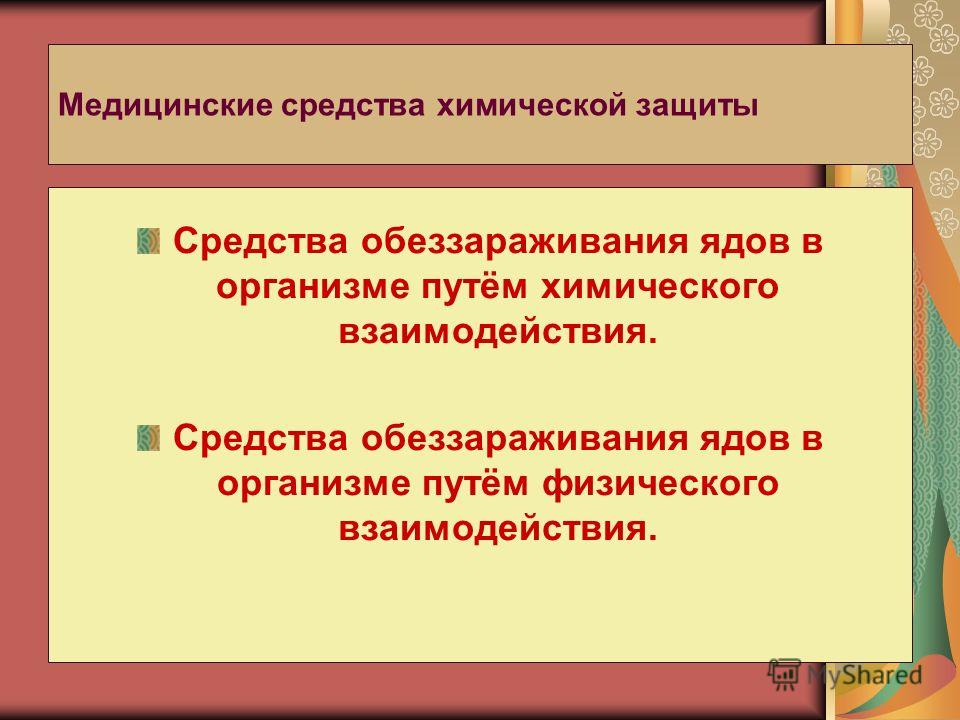
Medical means of radiation protection Means of preventing or weakening the primary general reaction of the body to radiation (sedative). Means for the prevention of radiation injuries during external irradiation (radioprotectors: cystamine, cysteine, cystophos, barium sulfate, ferrocin, pentacin). Means for the prevention of radiation injuries when radionuclides enter the body (adsorbents, stable iodine preparations).
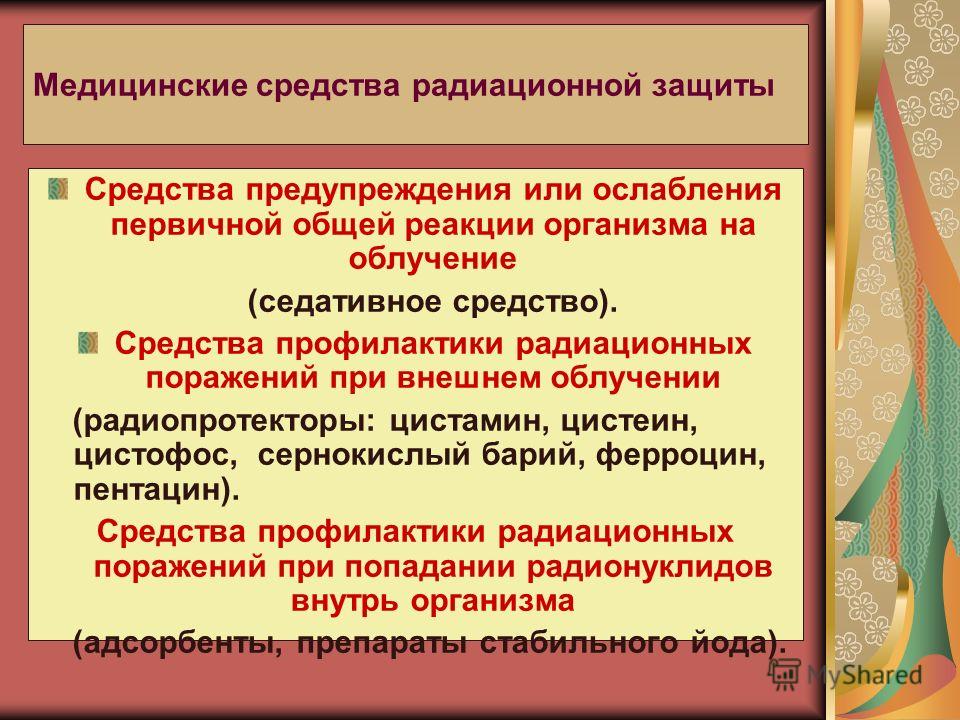
![]()
Fire-fighting personal protective equipment Liquid coolant - 5; ОЖ - 10. Chemical foam ОХП Carbon dioxide ОУ - 2; OU-5; ОУ - 8. Powder OP - 2; OP-5; OP-8B1. Aerosol OAX - freon. 1. The simplest fire extinguishing means: sand; water; asbestos and felt coatings. 2. Internal fire hydrants. 3. Fire extinguishers
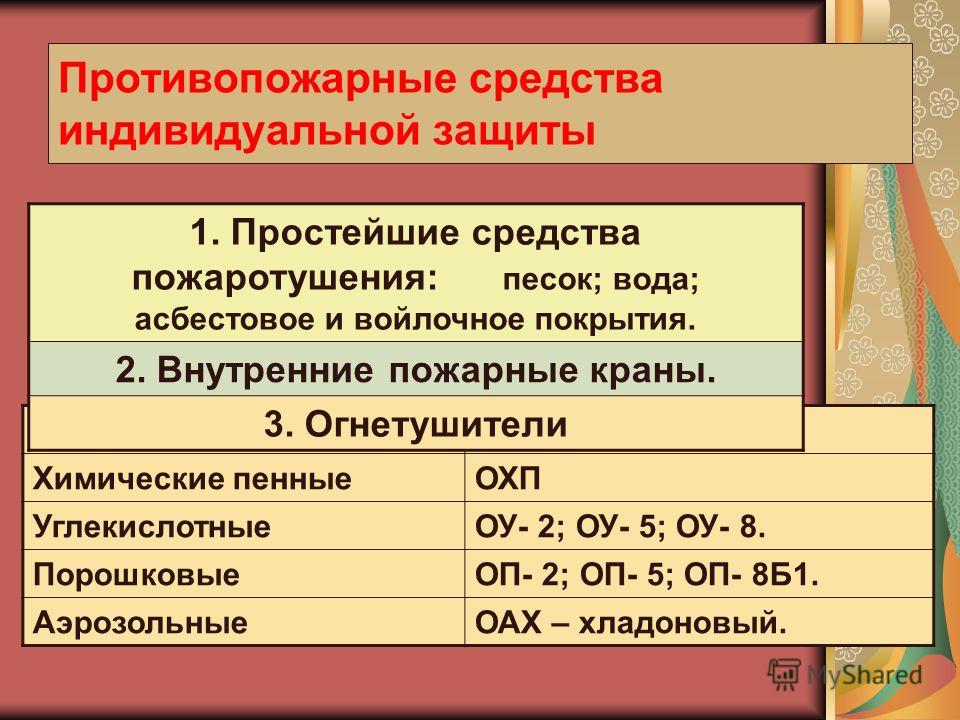
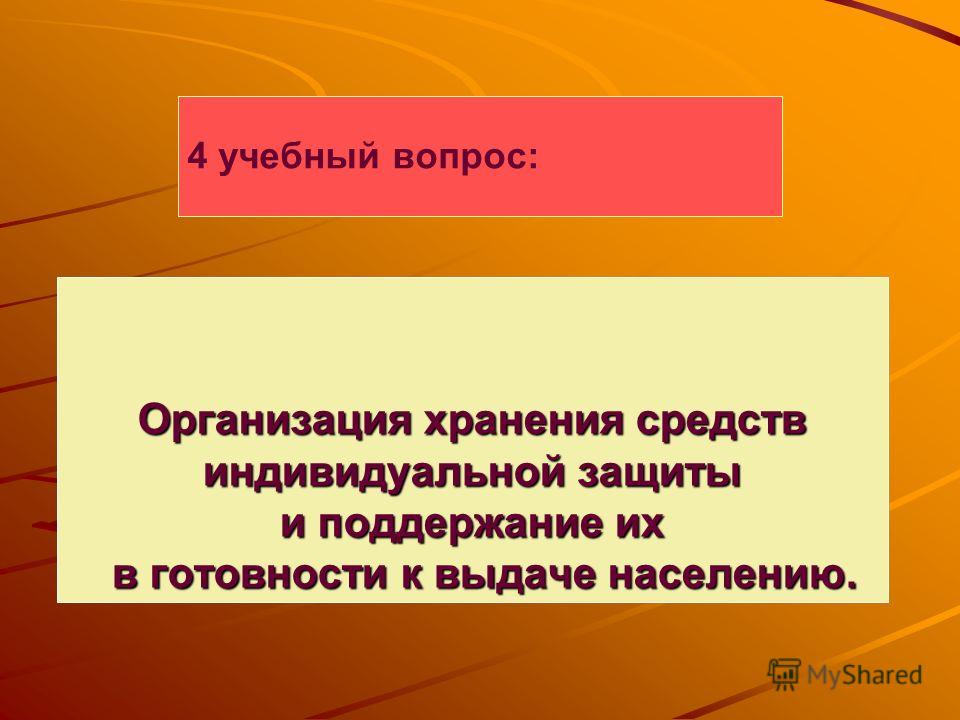
The provision of PPE is subject to the population living in: Peaceful time: in territories within the boundaries of zones of protective measures installed around the complex of storage and destruction facilities chemical weapons; in the territories within the boundaries of the zones of possible hazardous radioactive contamination (contamination) in case of accidents at the ROO; in the territories within the boundaries of the zones of possible hazardous chemical pollution (contamination) in case of accidents at HOO; in the territories within the boundaries of the zones of possible biological pollution (contamination) in case of accidents at the BOO. v war time: in the territories assigned to the GO groups; in settlements: - with objects "OV"; - railway station 1st, 2nd categories; - objects critical to the national security of the Russian Federation; in the territories within the boundaries of the zones of possible NBC.
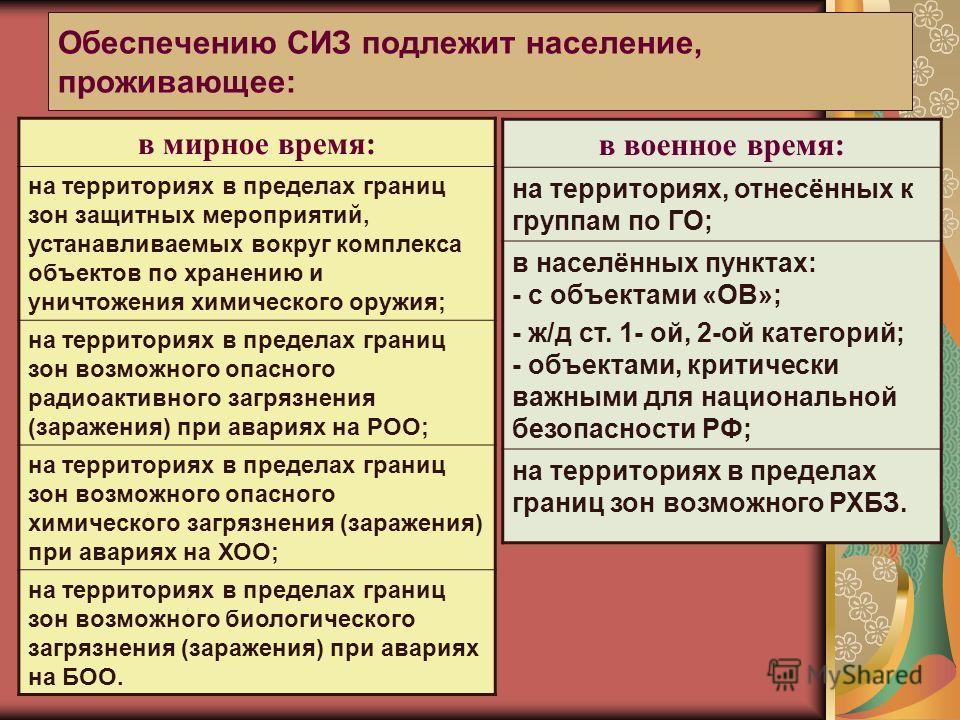
The accumulation of PPE in stocks (reserves) is carried out to ensure the implementation of civil defense measures and the protection of the population: for workers of radiation hazardous facilities, within the boundaries of zones of possible hazardous radioactive contamination (contamination) - (zone of hazardous RZ "B") gas masks and respirators (by 105% of their total number) and other PPE in accordance with the tables of equipment of the ASF, ACC, involved in the implementation of tasks for civil defense and protection of the population from emergencies. for workers of other organizations for the non-working population, gas masks and respirators at the rate (by 105% of their total number). for employees of other organizations living outside zones ("A"), ("B"), ("C"), ("D") gas masks (by 105% of their total number) and other PPE in accordance with the ASF equipment tables and ACC, involved in the implementation of tasks for civil defense and protection of the population from emergencies. for the non-working population, gas masks at the rate (by 105% of their total number). for children, children's protective cameras or gas masks (by 105% of their total number). To ensure the protection of the above categories of the population, accumulation in stocks (reserves) is also carried out: medical supplies individual protection: -in wartime at the rate of 100% of their total number; -in peacetime - by 30% of their total number; additional cartridges for gas masks for protection against emergency chemically hazardous substances (AHOV): -in war and peacetime at the rate of 40% of their total number.
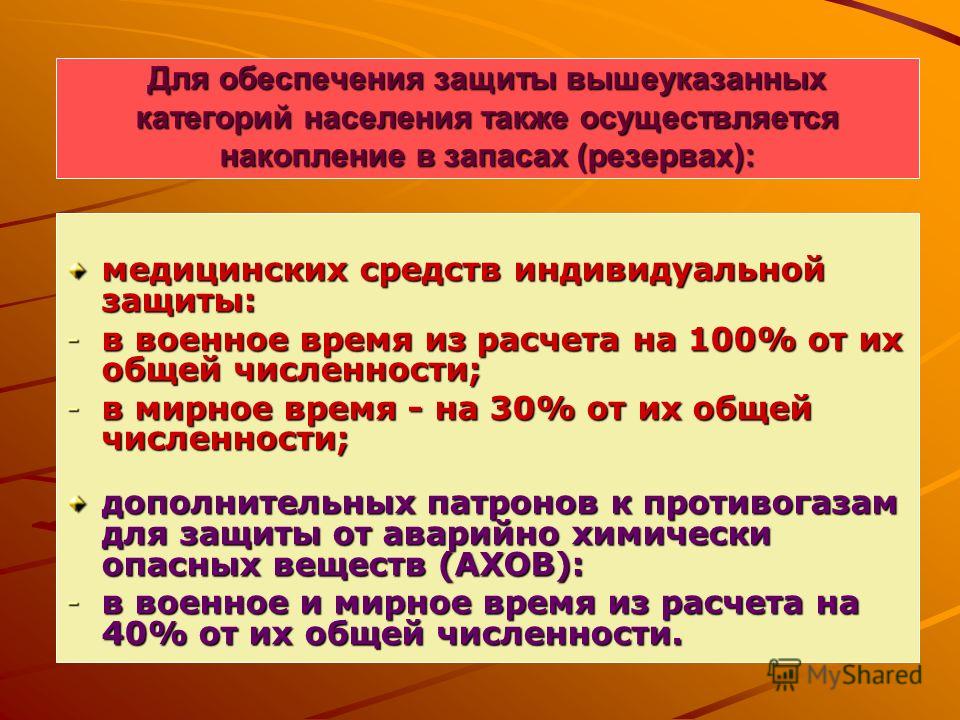
A set of personal protective equipment created and accumulated in the stock of GO: Name of PPE / MSIZ Population category Number Gas mask GP - 7 since 2009: GP-7BV (GP-7B), GP-10. Adult population 1111 Respirator U - 2K (R - 2) Adults 1 Gas mask PDF - 2Sh) School children 1 Gas mask PDF - 2D since 2009: Protective kit for preschool children with forced air supply ZKD - GZ Preschool children 1111 Additional cartridge DPG - 3 (for carbon monoxide) Additional cartridge of grades A; V; SX (chlorine) Additional cartridge K (for SX (ammonia) Adults, children of school and preschool age over 1, 5 years old Children's protective camera KZD - 6 Children of preschool age up to 1, 5 years old 1 Individual first aid kit AI-2 (with modifications ) Anti-chemical package IPP - 11) Personal dressing package PPI, PPI AV-3) since 2009: individual medical civil protection kit "Unita" (KIMGZ "Unita") The entire population of Russia
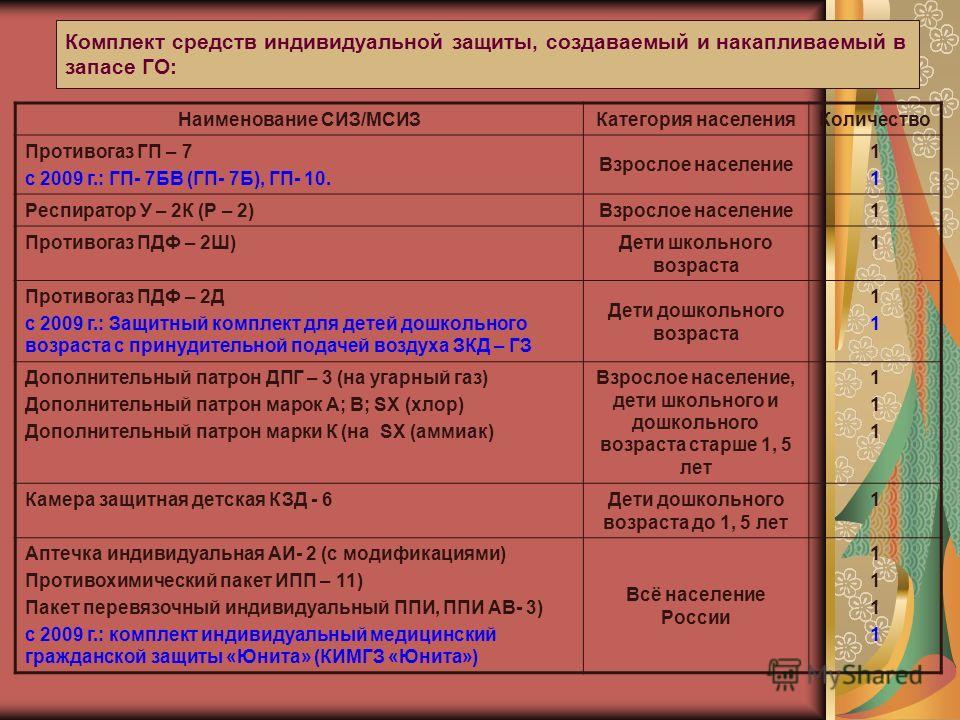
The provision of the population with personal protective equipment is carried out: executive power subjects of the Russian Federation: employees of these bodies and budgetary organizations under their jurisdiction, as well as the population living on the territory of the corresponding subject Russian Federation; local government bodies: employees of these bodies and the municipal enterprises and institutions created by them; organizations: employees of these organizations and their subordinate industrial and social facilities. federal executive bodies of the Russian Federation: employees of these bodies and budgetary organizations under their jurisdiction, and their family members;

- Before his death, Murat Nasyrov was in euphoria and dreamed of performing at the Eurovision Song Contest Murat Nasyrov sang to which group
- Taisiya Povaliy: biography, personal life, children, musical career, photo
- Justin Timberlake: biography, personal life, family, wife, children - photo American city where Justin Timberlake was born
- Tori karaseva after the project Victoria karaseva husband and children
- Glinka's biography and work (briefly)
- Step by step drawing basics
- Learn to draw a person with a pencil: step by step instructions
- Bang bang is running away my bunny
- Secrets of forecasting in Gosloto: the choice of numbers
- Lottery results 6 out of 49
- Secrets of forecasting in Gosloto: the choice of numbers
- Gosloto 7 of 49 results
- Where to buy a lottery ticket
- Why is half of the prize pool distributed?
- Features of the distribution of the lottery prize fund
- Play lotomaty cosmolot online
- Secrets of forecasting in Gosloto: the choice of numbers
- What is closing sales
- How to choose winning combinations
- Lottery draw with variants created by the "Fifteener" generator









